Books for Sale
I have recently cleared some of my shelving and am selling a number of military history books. These have been categorised and are listed below. I have looked on https://www.justbooks.co.uk/ to get an accurate idea of pricing and my prices match the cheapest found on that site (which itself searches 150 million books worldwide). P&P will be charged on top. I look forward to hearing from you and will keep the list updated when items are sold.

First World War
Memoirs/Biographies
Wully – Sir William Robertson – Molly Burkett. Softcover £14
Letters from a Flying Officer – Rothesay Stuart Wortley. Publisher: Sutton Pub Ltd. Softcover. £6
Her Privates We – Frederic Manning. Publisher: Serpent’s Tail, 1999. Softcover. £3
Margin Released – J.B. Priestley, Reprint Society, 1963, Hardcover. £5
Wearing Spurs – John Reith. Hardcover, Publisher: Hutchinson Of London, 1966. £5
A Minstrel In France (1918 Edition) – Harry Lauder. Hardcover. £25
“Khaki Courage: Letters in War-Time”, 1917 – Coningsby Dawson. Hardcover. Third Edition. £25
Guns, Kites and Horses: Three Diaries from the Western Front – Sydney Giffard. Hardcover. £3
Vain Glory. A Miscellany of the Great War 1914-1918 Written By Those Who Fought In It On Each Side and On All Fronts – Guy Chapman. Hardcover. 1937. £4
War Letters to a Wife (Spellmount Classics) – Rowland Fielding, Softcover. £3
War Memoirs of David Lloyd George – Volume II. Hardcover. £6
In Parenthesis – David Jones. Faber Faber, 2010. Softcover. £5
The Secret Battle – A.P. Herbert. Publisher: Oxford University Press, 1982. Softcover. £2
The Last Fighting Tommy – Harry Patch & Richard van Emden. Bloomsbury Publishing, 2007. Hardcover. £3
Memoirs of a camp-follower: a naturalist goes to war – Philip Gosse. Hardcover. 1942 edition. £20
Various – Great First World War Stories. Hardcover. £3
Letters from a Lost Generation – First World War Letters of Vera Brittain and Four Friends – Alan Bishop, Mark Bostridge. Softcover. £3
Testament Of Youth – Vera Brittain. Softcover. £3
Great War Fiction
The Regeneration Trilogy : Regeneration; The Eye in the Door; The Ghost Road – Pat Barker. Hardcover. Gardners Books, 1996. £3
All Quiet on the Western Front – Erich Maria Remarque. Hardcover. 1929. £6
Battles/Western Front/Weapons
Vimy Ridge – Alexander Mckee. Softcover. £3
R B Gardner – The Big Push. A Portrait of the Battle of the Somme. Hardcover. 1961. £5
In Flanders Fields: Passchendaele 1917 – Leon Wolff. Softcover. £2.50
Fire Power: The British Army: Weapons and Theories of War, 1904-1945, (Pen & Sword Military Classics) – Shelford Bidwell & Dominick Graham. Softcover. £4.
The Western Front From the Air – Nicholas C Watkins. Hardcover. £4
The Fifth Army in March 1918 – W. Shaw Sparrow. Publisher: The Bodley Head, 1921. Used – Fair. 1st edition. No dust jacket – with maps (some folding) & introduction by Sir Hubert Gough. Hardcover. £12
The British Army in the Great War – Frederick Hadley (Historial Museum of the Great War). Softcover. £5
Tanks Tank Weaponry and Warfare – Eric Morris. Hardcover. £3
Haig’s Command – Denis Winter. Publisher: Penguin, 2001. Softcover. £2.50
The Donkeys – Alan Clark. Softcover. £2.50
Gallantry
Liverpool Heroes, Book 3 – 17 Liverpool holders of the Victoria Cross – Ann Clayton (ed.). Softcover. £9
Supreme Courage: Heroic Stories from 150 Years of the Victoria Cross – Sir Peter de la Billiere. Hardcover. £3
Modern Guide Books
Battlefields of the First World War: A Traveller’s Guide – Tonie & Valmai Holt. Publisher: Trafalgar Square, 1993. Hardcover. £2.50
Old Guide Books
Muirhead’s Belgium and the Western Front (The Blue Guides) 1920 (Hardcover) £28
Battlefields of the Marne 1914. Michelin Tyre Co, London, 1919 Used – Good. First Edition. £10
Amiens. Before and During the War. A Panoramic History and Guide. Michelin’s Illustrated Guide: £9
Lille; Before and During the War; Illustrated Michelin Guides to the Battlefields 1914-1918; £13
Somme Vol 2 Second Battle of the Somme (Illustrated Michelin Guides): £26
CWGC
Unending Vigil: The History of the Commonwealth War Graves Commission – Philip Longworth, Pen and Sword, 2003. Softcover. £7
Remembered: The History of the Commonwealth War Graves Commission – Julie Summers. Hardcover. Excellent condition. £17
War Memorials & Remembrance
Tell Them of Us: Remembering Swindon’s Sons of the Great War 1914-1918 – Mark Sutton. Softcover. £8
Menin Gate and Last Post: Ypres as Holy Ground – Dominick Dendooven. Softcover. £2.50
The War Memorial – Clive Aslet. Publisher: Viking, 2012. Hardcover. £3
Not Forgotten – Neil Oliver, Foreword By Ian Hislop. Publisher: Hodder & Stoughton, 2005. Hardcover. £3
At the Going Down of the Sun: British First World War Memorials – Derek Boorman. Softcover. £4
Others
Public Schools and The Great War – Sir Anthony Seldon & David Walsh. Pen and Sword Military, 2014. Hardcover. £8
Six Weeks: The Short and Gallant Life of the British Officer in the First World War – John Lewis-Stempel. Softcover £2.50
Fritz and Tommy: Across the Barbed Wire- Peter Doyle; Robin Schäfer. Hardcover. Like new. £6
The Pity of War – Niall Ferguson (Allen Lane History). Hardcover. £3
Virtual History: Alternatives and Counterfactuals – Niall Ferguson. Publisher: Penguin Books, 2011. Softcover. £3
The Great War and Modern Memory – Paul Fussell. Softcover. £2
Marjorie’s War: Four Families in the Great War 1914-1918 – Charles Fair. Softcover. Like new. £10
Empire – Jeremy Paxman. Publisher: Viking, 2011. Hardcover. £4
Berkshire in the First World War. Commemorative book produced by Reading Borough Libraries and funded by the Heritage Lottery Fund. Edited by John Arcus. Publisher Goosecroft Publication 2015. Softcover. £8
The First World War: A Very Short Introduction – Michael Howard, Oxford University Press, 2007. Softcover. £3
A Group Photograph – Before, Now & in-Between: A History & Art Project 2016 – Andrew Tatham, Publisher: Stad Ieper – Musea, Softcover. £6
Quick Training for War – Lt Gen Sir Robert Baden-Powell: £6
Second World War
Battles
‘DUNKIRK, THE NECESSARY MYTH (CORONET BOOKS)’ – Nicholas Harman. Softcover. £2
Stalingrad (Hardcover) – Anthony Beevor: £8
Berlin (Softcover) – Anthony Beevor: £5
The Desert Generals (Hardcover, First Edition, 1960) – Correlli Barnett: £36
The Battle of the Bulge (Hardcover) – Charles B. MacDonald: £4
Overlord (Hardcover) – Max Hastings: £3
Diaries
Triumph in the West 1943 – 1946. Based on the Diaries and Autobiographical Notes of Field Marshall The Viscount Alanbrooke (Hardcover): £3
Alanbrooke War Diaries 1939-1945: Field Marshall Lord Alanbrooke – Ed by Alex Danchev & Daniel Todman (Softcover): £3.50
With the Jocks: A Soldier’s Struggle For Europe 1944-45 (Softback) – Peter White: £3.50
War at Sea (all Softback)
Stealth at Sea: The History of the Submarine – Dan Van Der Vat: £3
Convoy – Martin Middlebrook: £2.50
The Greatest Raid of All (St Nazaire Raid or Operation Chariot) – C.E. Lucas Phillips: £2
A Brilliant Little Operation: The Cockleshell Heroes and the Most Courageous Raid of World War 2 n – Paddy Ashdown (Hardback): £3
The Sinking of the Bismarck – Will Berthold: £3.50
The Sinking of the Lancastria – Jonathan Fenby: £5
Air War
RAF Bomber Command in the Second World War: the Hardest Victory – Denis Richards: £3
Dresden – Frederick Taylor: £3
No Passing Glory: The full and authentic biography of Group Captain Cheshire, V.C., D.S.O., D.F.C. (Hardcover) – Andrew Boyle: £7
The Second World War (Six Volumes) – Winston Churchill – £60
(1) The Gathering Storm – (2) Their Finest Hour – (3) The Grand Alliance – (4) The Hinge of Fate – (5) Closing the Ring – (6) Triumph and Tragedy
German History, Nazi Germany & the Holocaust
Hitler’s Willing Executioners: Ordinary Germans and the Holocaust – Daniel Jonah Goldhagen: £4
The Rise and Fall of the Third Reich – William Shirer: £4
A History of Germany 1815-1990 (Fourth Edition. Hardcover) – William Carr: £3.50
The Fontana History of Germany 1918-1990 – Mary Fullbrook: £2
Espionage/Spying/POW
A Man Called Intrepid – William Stevenson: £4
Spies Beneath Berlin (Hardcover) – David Stafford: £3
They Have Their Exits (Hardcover) – Airey Neave DSO MBE MC: £5
Others
The Spanish Civil War (Softback) – Anthony Beevor: £3
Band of Brothers – Stephen E Ambrose (Softback): £2
Whicker’s War (Hardcover) – Alan Whicker: £2
Gardens of Stone: My Boyhood in the French Resistance (Hardcover) – Stephen Grady: £3
Monty: the making of a General 1887-1942, Vol 1 (Softback) – Nigel Hamilton: £3
The Call-Up: A History of National Service – Tom Hickman, Publisher: Headline, 2005. Softcover. £3
A raid with severe repercussions: the mutilation of 8th Lincolns dead at Ghissignies, 2-3 November 1918
In the course of research for a client whose relative had served in the 13th Battalion Royal Fusiliers I was reading the unit war diary when the following passage, taken from 11 November 1918, the day the armistice came into effect, stopped me in my tracks:
11 November 1918
Bodies of dead killed on 24/10/18 were buried at GHISSIGNIES. It was found that the majority of the men had been deliberately shot in the head by the enemy. The men in question had been wounded: those that were able to walk were taken by the enemy and the remainder dealt with as stated above. Bodies of men of the Lincolnshire Regt. who had been killed about 30th Oct. were found to have been mutilated, hands hacked off at the wrists and eyes gorged [sic] out.
[13th Battalion Royal Fusiliers War Diary, UK National Archives, Ref: WO95/2538/3]
I have read plenty of British atrocities against German troops on the Somme in 1916 (there are files of such accounts in the archives at Freiburg). But on the British side I was only aware of Major Henry Hance’s (179 Tunnelling Company RE) description of Mash Valley on the Somme in mid-July 1916 in which he describes the British dead having been bayoneted ‘always thro’ the neck’ and the dead hanging on the wire having head their heads bashed in. But the 13th Royal Fusiliers war diary extract invited more research. Could this really have happened – British soldiers with hands hacked off and eyes gouged out by the enemy?
No additional information was available in the 13th Royal Fusiliers diary so moved on to the 8th Lincolnshire Regiment’s diary. The 13th Royal Fusiliers’ account had mentioned the battalion’s dead ‘who had been killed about 30th Oct.’ A brief look at the 8th Lincolns’ war diary confirmed any dead could not have been from that date (the battalion were in the line under heavy shellfire and had two Other Ranks wounded). Much more likely was the night of 2-3 November when ‘A’ Company raided German posts at the northern end of the village of Ghissignies, southwest of Le Quesnoy (of New Zealand Division fame).
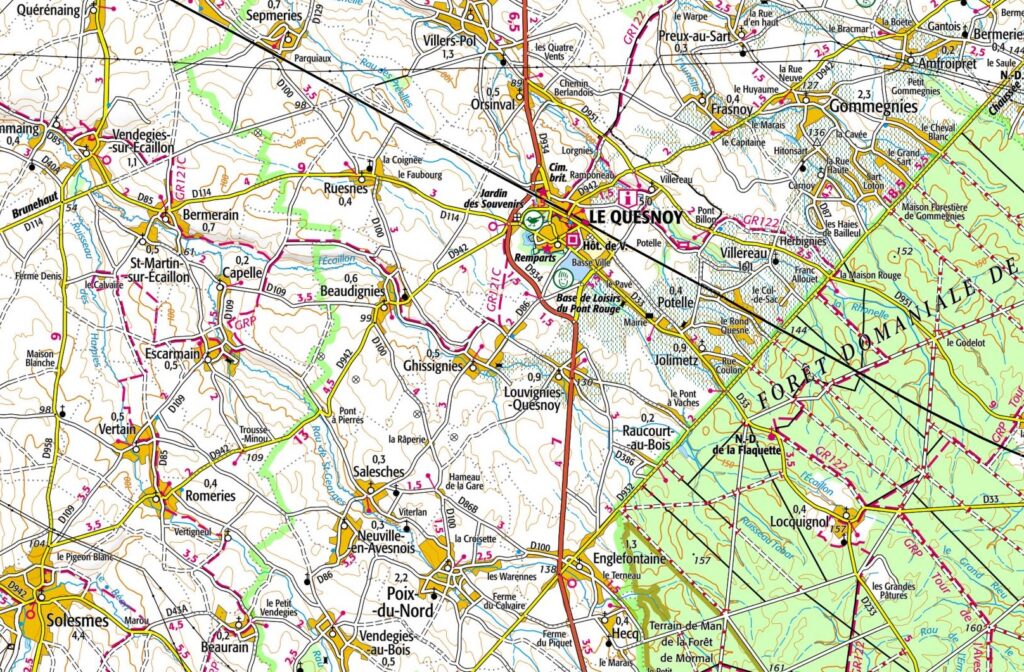
IGN map showing Ghissgnies in relation to Le Quesnoy
A Google Maps link to the village of Ghissignies can be found by clicking HERE.
The relatively sparse diary entries for 2-3 November are recorded below:
2/11/18 In the line – “A” Coy raided posts at level crossing in X5a at 23.45 hrs. Between 30 & 40 casualties inflicted on enemy. Heavy resistance offered. Casualties 11 O.R. killed, 18 O.R. wounded, 1 O.R. missing, 1 O.R. acc[identally] wounded.
3/11/18 In the line – Trench mortar activity on front line – casualties 12 O.R. killed, 17 O.R. wounded, 1 O.R. missing, 1 wounded acc. sprained wrist.
[8th Battalion Lincolnshire Regiment War Diary, UK National Archives, Ref: WO95/2529/1]

Annotated map extract from 37th Division HQ war diary showing Ghissignies and the chapel crossroads with area of raid marked
Clearly, the success of a single company raid which resulted in 31 casualties to the attacking force is questionable. The following day the Battalion cleared the position raided on 2 November with relatively little loss. Their casualties that day were the last sustained by the Battalion in the Great War.
4/11/18 “D” Company withdrew 2 platoons to SALECHES in X.19.b – 2 platoons followed left flank 111th Infantry Brigade mopping up the crossing & orchards in vicinity of chapel in X.5.a & b and R.35.. c & d. – 1 platoon establishing posts X.5.b.30.85 to R.35.d.15.15 –1 platoon X.b.20 – 70 to X.5.b.10.90. 24 prisoners captured in this operation – working from the south, 2 platoons of B. Coy mopped up Railway to Level Crossing in X.5.a.
In the evening the Bn moved to LOUVIGNY in area S.8.b & d.
[8th Battalion Lincolnshire Regiment War Diary, UK National Archives, Ref: WO95/2529/1]
As is so common when studying trench raids, the area in which this action took place is very small. British wartime maps (above) show the Le Quesnoy road leading to a crossroads at the north-eastern edge of the village. A chapel is marked on the crossroads but online research shows this to have been the existing calvary which was unveiled in 1852.
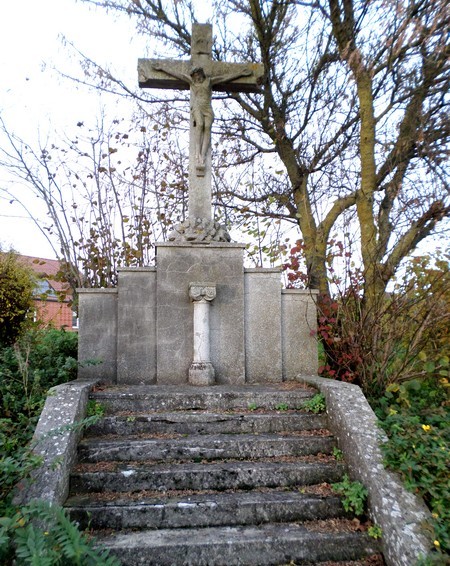
The Calvaire at the crossroads, Ghissignies. Image from: http://villesetvillagesdelavesnois.org/ghissignies/ghissignies.html
As part of 63rd Infantry Brigade, I hoped that the 8th Lincolns’ raid of 2-3 November would receive more attention in the Brigade war diary. And it was here that I struck gold with a detailed account provided in a Report on Operations, Oct 23rd – Nov, 4th, 1918, including gruesome descriptions of disfigurement and mutilation of British dead:
Nov 2nd.
At 2345 hours 8th Lincolnshire Regt. raided the enemy’s positions on the railway about the Chapel, X.5.a., under an artillery and trench mortar bombardment. This raid was carried out on a one platoon front with one platoon in close support. The railway was entered by the leading platoon and several casualties were inflicted on the enemy. 3 prisoners were taken but subsequently escaped. The supporting platoon was unable to reach the railway owing to heavy hostile machine-gun fire from the railway cutting. Our casualties were somewhat heavy, including 12 other ranks reported missing. In the subsequent advance on the 4th inst., the bodies of 11 were found buried by the enemy in the railway cutting. On being examined the bodies were found to have been terribly disfigured. One, the body of No. 241186 Corpl. G.A. DICKENSON, had six bayonet wounds, and one hand cut off. In addition both eyes were missing and had apparently been gouged out. It is not thought possible that these wounds could have been inflicted in the course of actual fighting.
[63rd Infantry Brigade War Diary, UK National Archives, Ref: WO95/2529]
A railway embankment bisected the Le Quesnoy road just before the crossroads. However, as noted in 63rd Brigade diary, British maps of the area were not wholly accurate:
The maps of this area had been found to be very misleading: what was taken to be a level crossing at X.5.a.5.5 was proved to be a very steep railway cutting fully 12 feet deep with a destroyed road bridge over the railway.
So, for the two assaulting platoons, what had appeared to be a standard raid had swiftly deteriorated into a tragic and bloody action. The war diary for 37th Division General Staff HQ reiterates the salient points of the raid:
Successful raid carried out by 63rd Brigade at 23.45 hours. Objective of raid level crossing X.5.a. Raiding party reached objective and inflicted severe casualties on the enemy. 3 prisoners were taken but owing to the escort being wounded on their way down with prisoners they escaped.
[37th Division Headquarters Branches and Services: General Staff War Diary, UK National Archives, Ref: WO95/2515]
However, it was 37th Division Intelligence Summary No 8., dated 7 November 1918 that provided most detail. It showed that the attacking force was met by sustained machine gun fire as soon as the advance began. One party working north along the railway made it into the 12ft deep railway cutting which was full of cubby holes, both at the bottom and higher up. Heavy fighting ensued and the report concluded thirty casualties were sustained by the Germans (almost certainly an overestimate – there are countless examples of British estimates of German casualties in raids bearing no relation to actual losses recorded in German reports. These numbers should always be treated with a healthy dose of scepticism – after all, those making the claim knew all too well there was no way their superiors could check inflated claims). Having suffered heavy casualties themselves and low on bombs and ammunition, the party withdrew. Other parties aiming to work south along the railway were stymied by sustained machine gun fire which caused heavy losses amongst the attacking Lincolns.
There is also mention of three German prisoners shooting their lone escort and escaping and a warning that prisoners should be properly searched for weapons upon capture to prevent such instances occurring.
7/11/18.
A raid was carried out on the night 2/3rd of November by two platoons of the right Bn in the vicinity of the level crossing in X.5.a. at 23.45 hours. The assembly was successful, but two machine guns, one on the railway crossing and the other about 30 yards north of the house X.5.a.40.35 opened fire immediately the party started to advance. One party, working north along the railway reached the hedge in spite of heavy fire, crossed it, and dropped into the railway cutting which was found to be full of cubby holes, both at the bottom and higher up.
The party started to mop up at once but was unable to reach the machine-gun at the level crossing. 30 casualties were inflicted on the enemy in spite of considerable opposition, particularly from the men in the upper cubby holes.
The party was finally forced to withdraw, their bombs and ammunition being exhausted and only one officer and 2 O.R. remaining unwounded.
Three prisoners was sent back under a lightly wounded escort. One of those prisoners drew a revolver and shot his escort. The escort of the other two was again wounded whilst withdrawing and they also escaped.
Other parties attempting to mop up posts in X.5.a.5.4 and to work south along the railway were unable to gain ground owing to heavy machine-gun fire in spite of repeated efforts to knock out the guns. The majority of our men were wounded in this attempt.
The raid was successful in that it showed that the enemy was still holding this section of the front in strength.
NOTE. The loss of the three prisoners emphasises the fact that prisoners should be thoroughly searched for weapons directly they are captured.
[37th Division Headquarters Branches and Services: General Staff War Diary, UK National Archives, Ref: WO95/2515]
Based upon these accounts it seems most likely the soldiers recorded in 63rd Brigade war diary whose ‘bodies were found to have been terribly disfigured’ probably came from the party which entered the railway embankment and fought so bitterly with the enemy ensconced in their cubby holes. Sadly, I doubt it will be possible to find further information on the events of that night – whether or not the wounds to British soldiers were deliberate but experience leads me to believe they were. The troops had seen their fair share of fighting and killing and knew the difference between wounds sustained in the course of action and deliberate mutilation. That these accounts are taken from official British sources (war diaries from Battalion, Brigade and Division) as opposed to a post-war memoir also adds credence to their veracity. Furthermore, by this stage of the war there was no need for inflated accounts of German atrocities to be used for propaganda.
It is certainly possible that assaulting Lincolns who entered into a bloody fight in the railway embankment, killing a number of German defenders were offered no mercy. Maybe German survivors were not in the mood to take prisoners and wanted revenge? To assume such incidents did not happen over four years of a bitter war is naïve and misses the essential point of warfare – namely, to kill the enemy.
As for the 8th Lincolns dead, there are sixteen soldiers from the Battalion now buried in a long line in the nearby Ghissignies British Cemetery. Based upon the sources above, eleven of these were disinterred from their shallow burial in the railway embankment – these are the men whose bodies were disfigured – with the remaining five ‘conventional’ casualties from the action (most likely from machine gun fire as they attempted to work south along the railway).
Below is a list of these dead taken from the CWGC website.
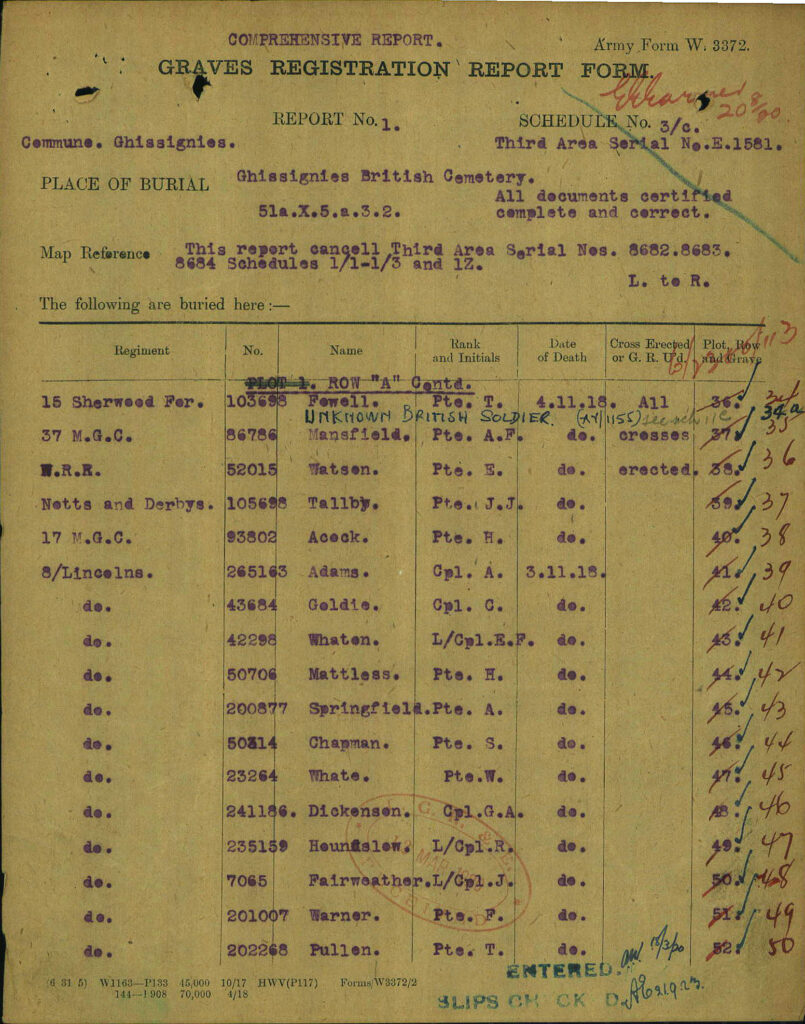
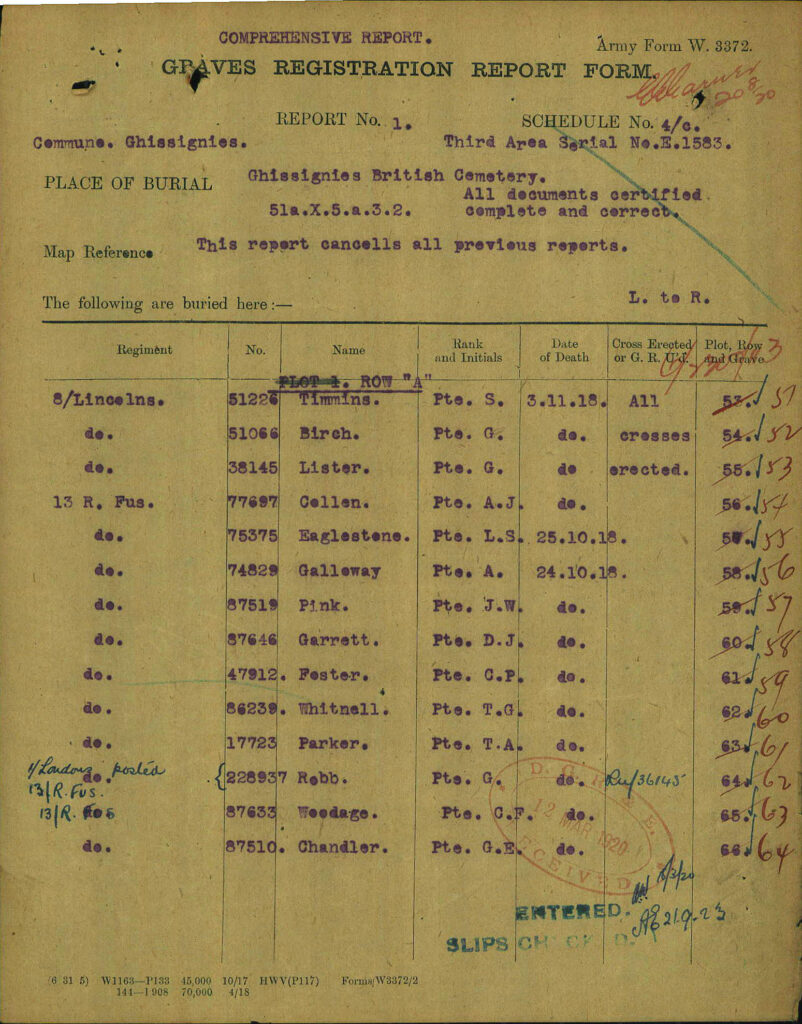
It includes 241186 Corporal George Dickenson whose body had six bayonet wounds, one hand cut off and both eyes missing (apparently gouged out). Two graves along lies 7065 Lance Corporal John Fairweather MM, a recipient of the 1914 Star who went overseas with the 1st Battalion in September 1914, served with a number of different battalions and earned the Military Medal in 1917. I would welcome any further detail on these men. Many of the dead from this raid are listed in the Weekly Casualty List (War Office & Air Ministry ) for 28 January 1919.
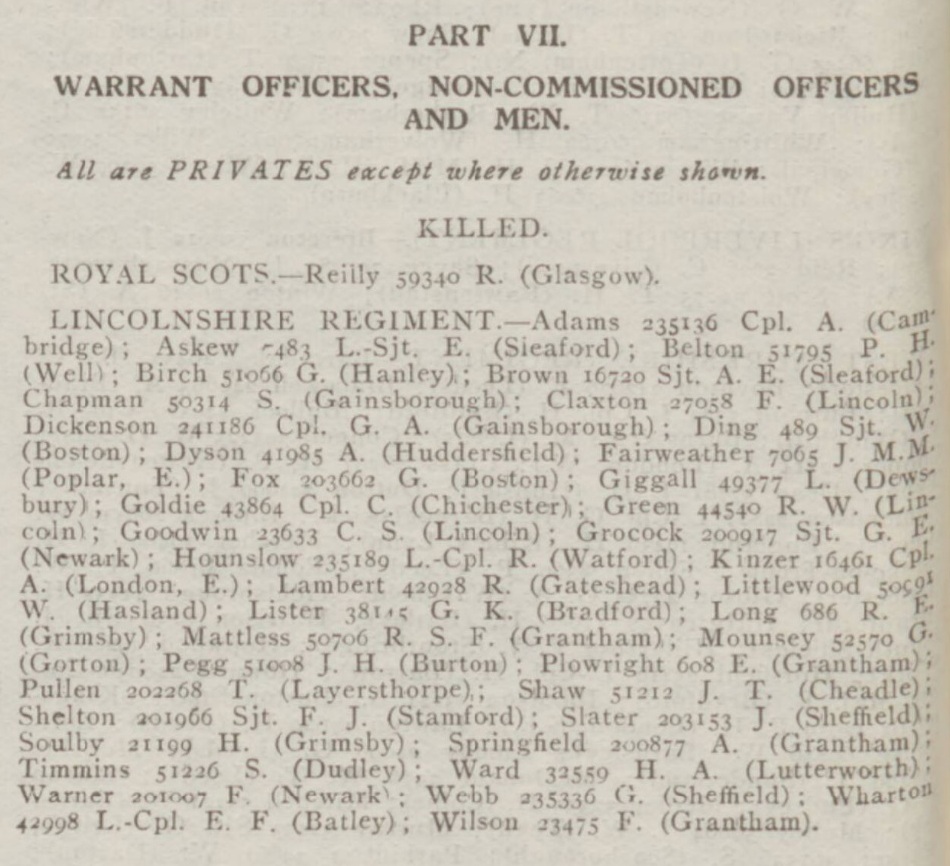
Weekly Casualty List (War Office & Air Ministry ) – Tuesday 28 January 1919
So, a strange and disturbing case of battlefield mutilation right at the end of the war. The village is once more a quiet spot and a roundabout now sits at the road junction. A water tower has been built between the Route de le Quesnoy and Route de Louvigny. Other than the military cemetery 100 metres down the road towards the village centre there is nothing to indicate any fighting took place here. When we get out of lockdown and visits to France and Flanders recommence I will stop at Ghissignies, far from the well-trodden spots of the Ypres Salient or the 1916 Somme battlefield and pay my respects to those men killed just a few days before the guns fell silent.

Modern aerial view of raid site at Ghissignies. Taken from Geoportail
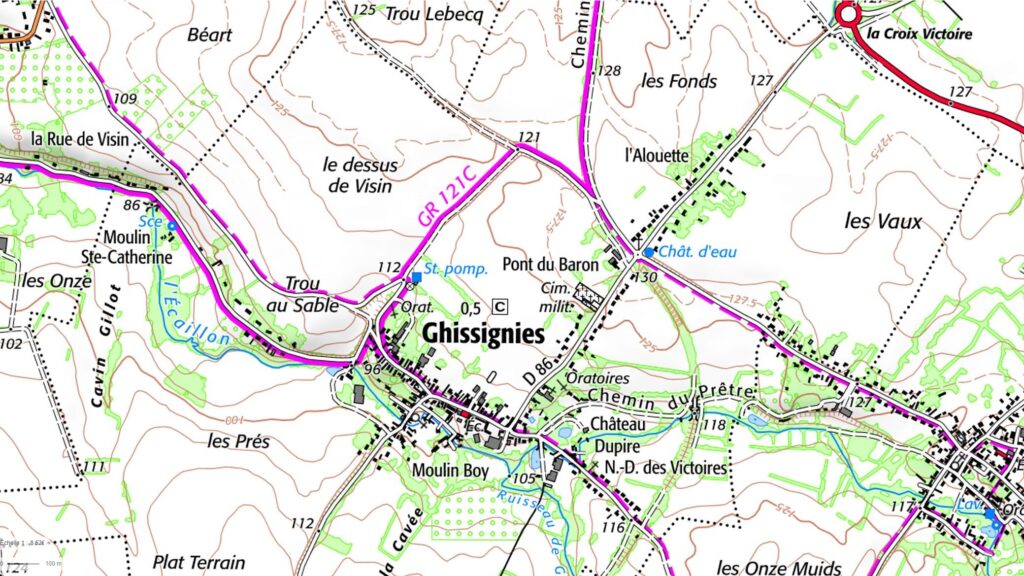
IGN map of the village of Ghissignies
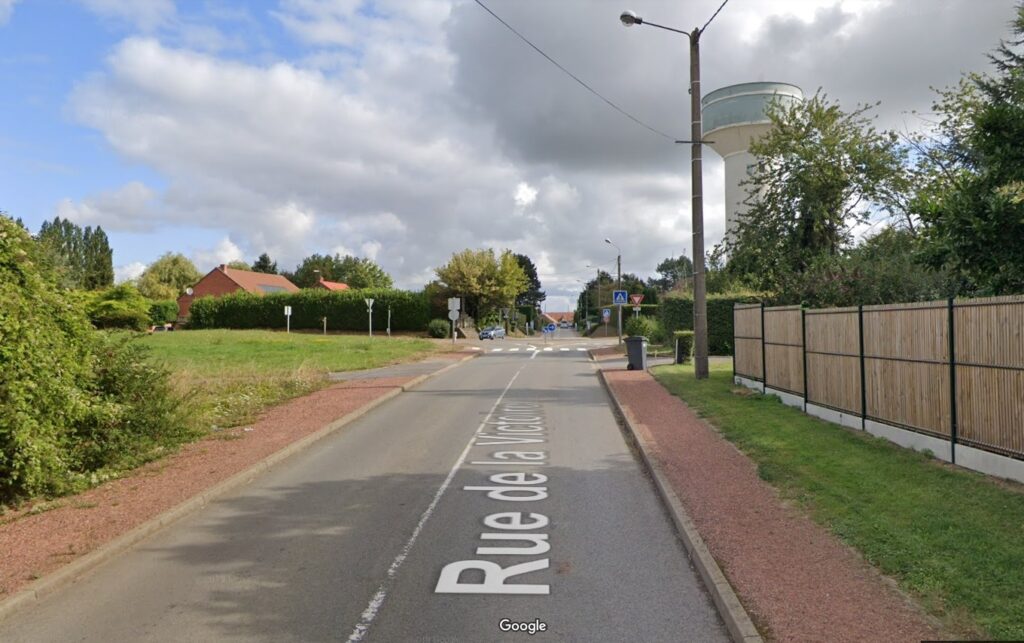
Image from Google Street View looking up to site of railway embankment and raid
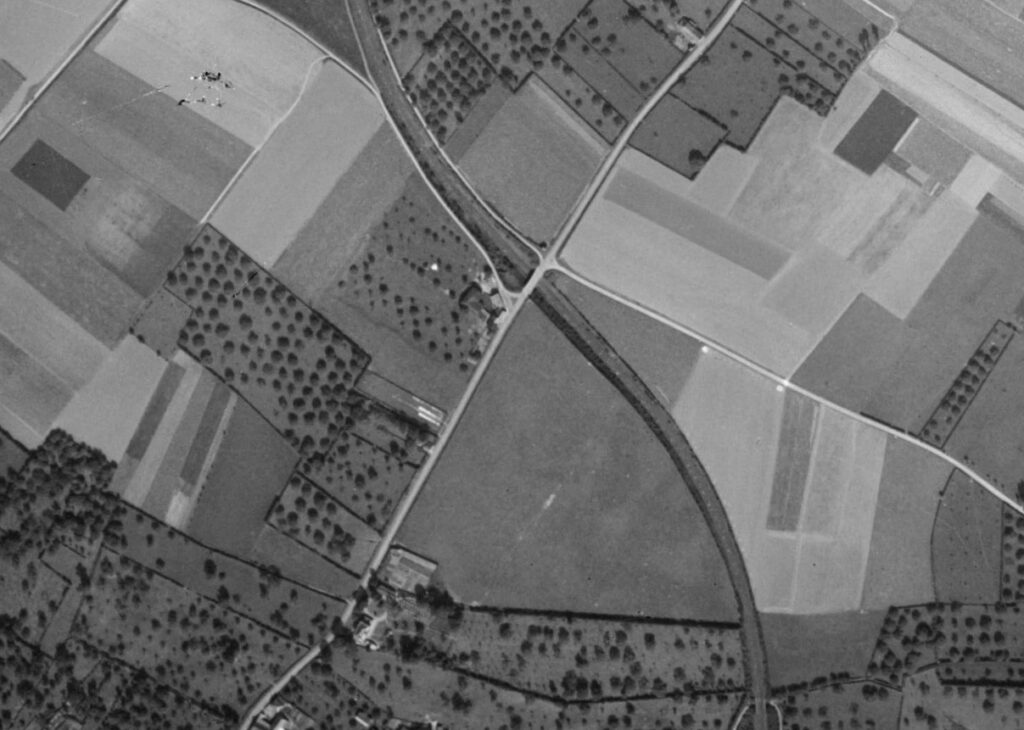
13 Sept 1949 aerial of Ghissignies, the railway embankment and crossroads
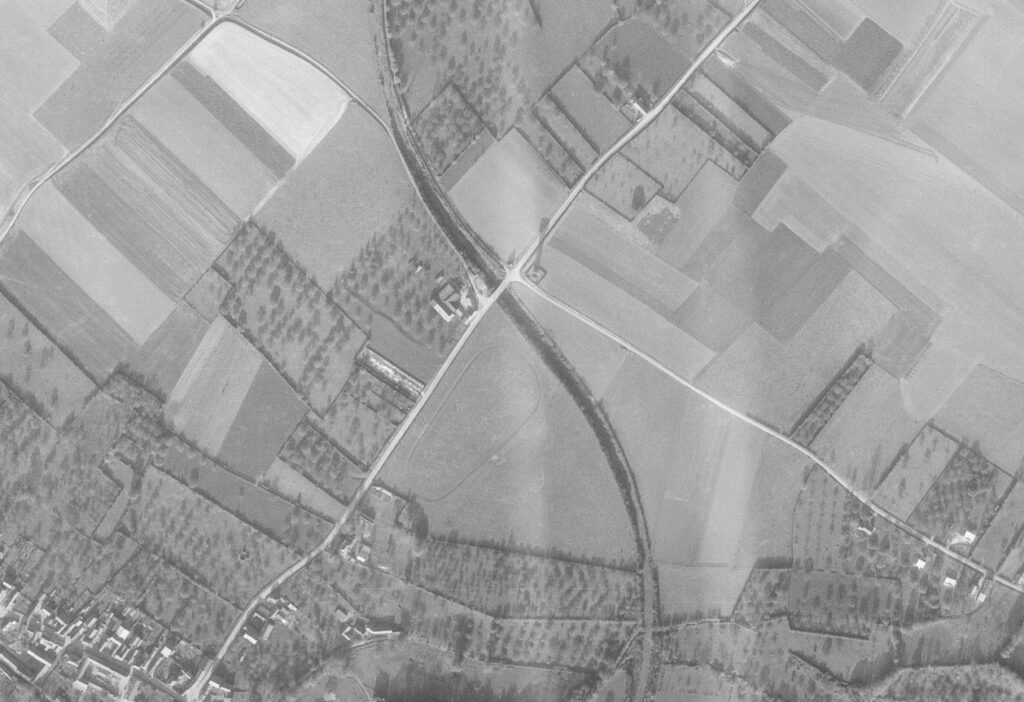
15 November 1968 aerial of Ghissignies showing water tower to the east of the crossroads
JB, 31 March 2021
Following the success of the four years of Bristol and West Country based battlefield tours (2016-19) organised with fellow historian, Clive Burlton, we are pleased to announce another trip for autumn 2021. Our 2020 tour was cancelled due to the coronavirus pandemic, hence we are carrying over our suggested plans for that tour to 2021. Our focus is not solely actions by units from the West Country but on this tour will look at the role of the Tunnelling Companies and their incredible underground war, fought deep beneath No Man’s Land. We will also visit sites and tell stories associated with the post-war reconstruction of French communities.
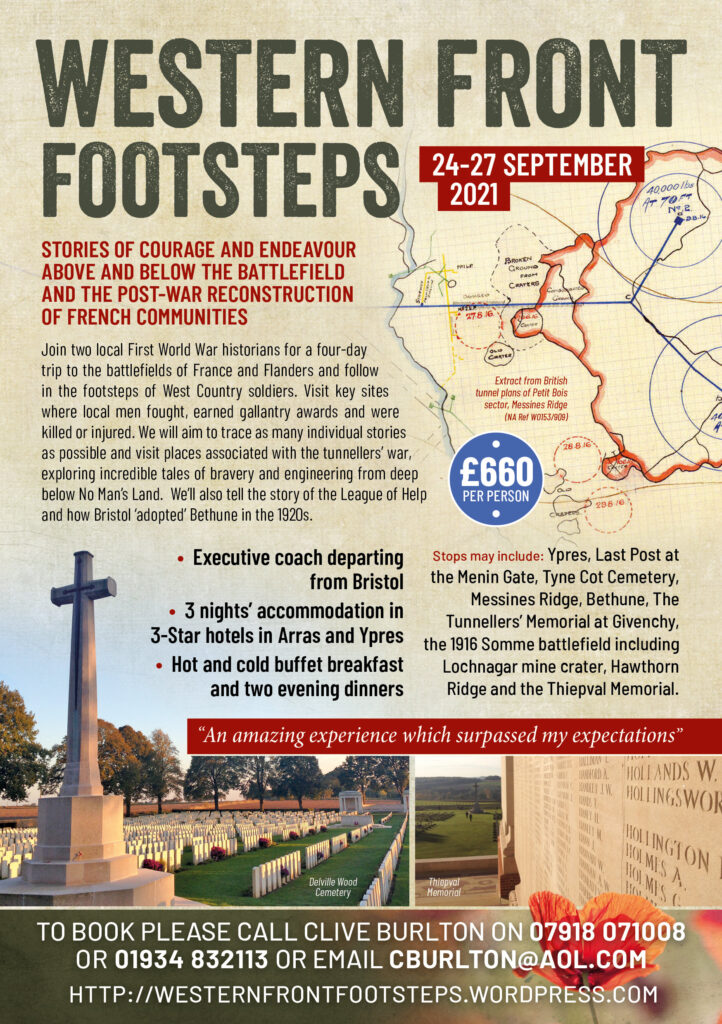
Once again we are travelling with our partners at Bakers Dolphin. The three night, four day tour will visit key sites associated with the West Country. Travelling by executive coach we will depart from Bristol on 24 September and travel to Arras, stopping at sites of interest en route.
The next day will be spent on the 1916 Somme battlefield with a look at the tunnelling exploits at such famous sites as Hawthorn Ridge, La Boisselle, Bois Francais and Carnoy. As ever we will ensure that we stop at key battlefield sites including the Thiepval Memorial.
On 26 September we will journey northward to the sacred Ypres salient and Messines Ridge, a key battleground for the tunnelling war. En route we will visit Bethune and the Tunnellers Memorial at Givenchy-les-la-Bassée for the tale of Sapper William Hackett VC, the only tunneller recipient of the Victoria Cross. Whilst in Ypres we will attend the Last Post ceremony at the Menin Gate. Other key sites around the salient will be explored.
As ever, our tour will cover the stories of relatives of those who join us. Please do send details and we will endeavour to visit individual graves and battlefield sites if time permits.
Accommodation is based at the following 3-star hotels – Holiday Inn Express (Arras) and the Novotel (Ypres). Full details of cost, what is included and contact details to reserve a space can be found on the attached flyer and via our dedicated website: https://westernfrontfootsteps.com/.
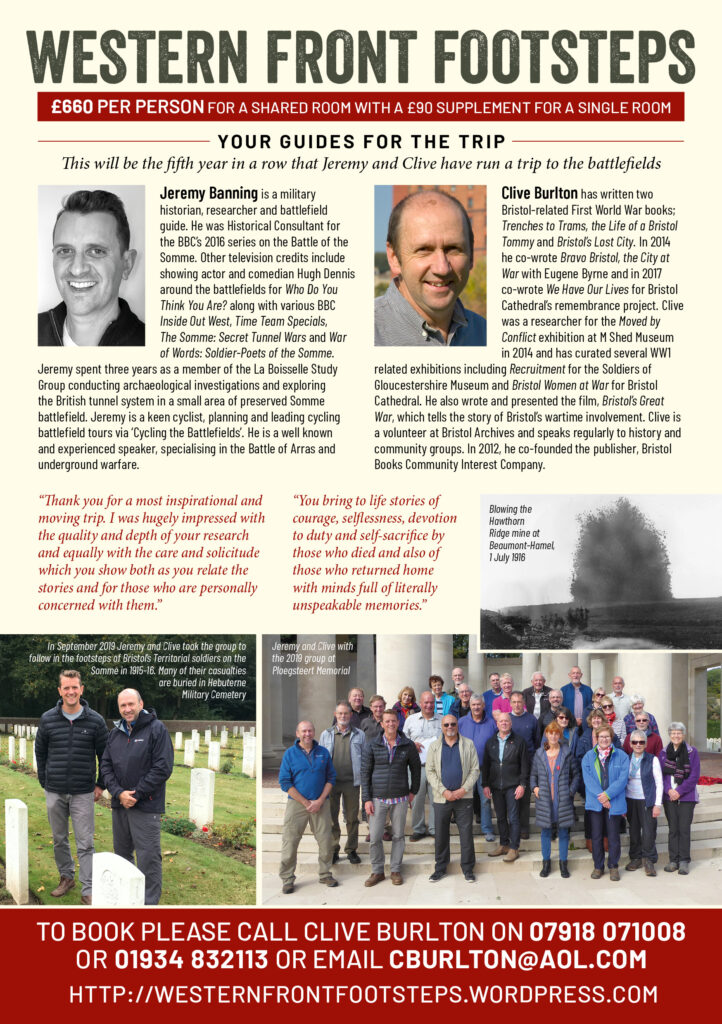
We look forward to you joining us for another wonderful few days following in some Western Front Footsteps…
Filming with David Walliams for Who Do You Think You Are? and a look into his great-grandfather’s wartime service
Back in early March just before lockdown I spent a half day filming with David Walliams at the Guards’ Chapel for the new series of Who Do You Think You Are? David’s episode was broadcast tonight, 19 October, on BBC One. I was asked to set the scene for David’s great grandfather, John Boorman, who served in the Grenadier Guards.
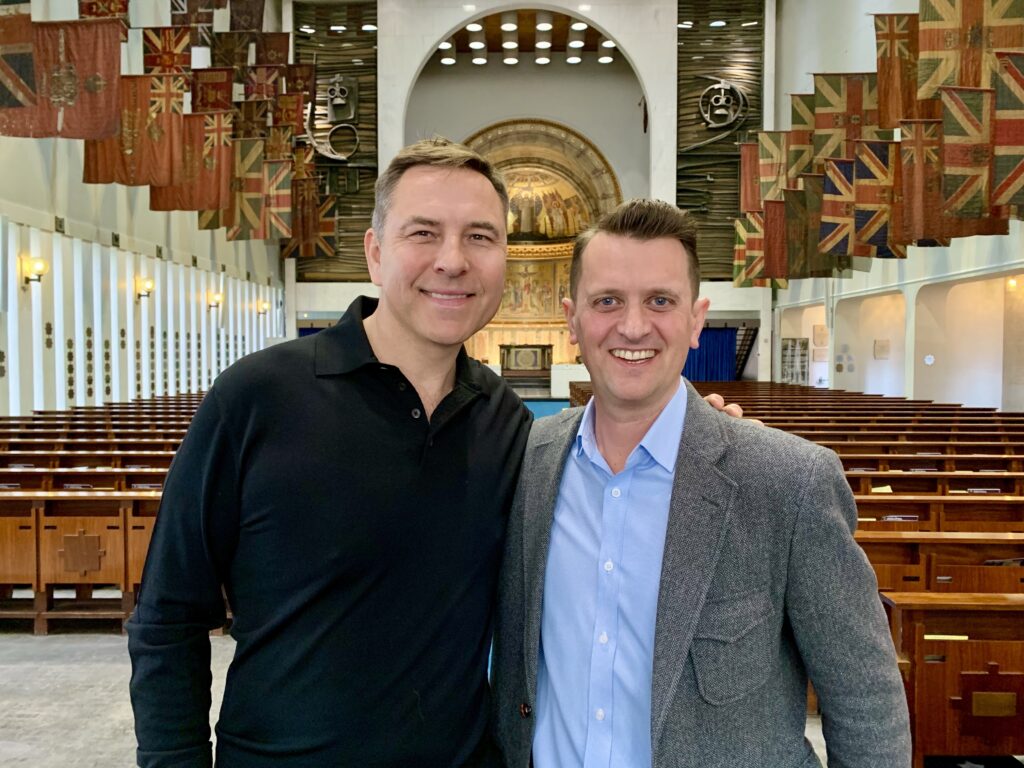
With David Walliams at the Guard’s Chapel filming Who Do You Think You Are?
His was a fascinating but ultimately tragic story. Having enlisted at the end of September 1914 it is possible that his above average build (he weighed 140 pounds and had an expanded chest of 36 inches) alongside his height of 5 feet 9 inches meant he was guided in the direction of the Guards by recruiters.
Having undergone training John proceeded overseas. His Medal Index Card and surviving service record confirm his date of arrival in France as 16 March 1915. John joined the 1st Battalion and while the service record does not say when he joined them, the battalion’s war diary notes the arrival of a draft of six officers and 350 men on 20 March 1915. It is assumed John was in this draft.
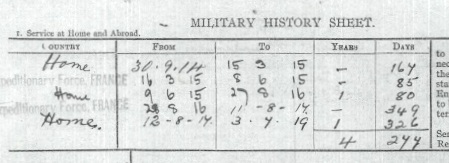
Extract from John Boorman’s service record showing time spent in the UK and overseas
Two months of trench routine and a few weeks break in divisional reserve during which the battalion practice drill and route marching precede John’s first battle, the Battle of Festubert. In comparison to the titanic battles of 1916 & 1917 this affair, in the flat lands of French Flanders, was small but no less bloody. To soften up German positions over 100,000 shells had been fired before the assault. Early in the morning of 16 May the 1st Grenadier Guards followed behind the 2nd Border Regiment, passing through them to attack German trenches. There was no great distance gained and it certainly didn’t alter the course of the war but this action was John’s first taste of the harsh brutality of war. Battalion reports describe close quarter fighting, killing the enemy, taking prisoners plus clearing trenches by throwing bombs. It was a tough baptism of fire, as recorded in Ponsonby’s Volume 1 of The Grenadier Guards in the Great War of 1914-1918:
The 1st Battalion Grenadiers came in for a great deal of shelling, and one shell burst in the middle of No. 8 Platoon, killing four men and wounding many others, including Lieutenant Dickinson and Lieutenant St. Aubyn, who was struck in the face by a piece of shrapnel. All the time a stream of wounded from the front trenches was passing by, some walking and some on stretchers.
Another entry in the Guards’ history records:
Rain began to fall at 6 p.m., and grew into a steady downpour. In the newly won trenches the men were soaked to the skin, and spent a miserable night. Everywhere the wounded, both British and Germans, lay about groaning.
For someone with only two months service in France those images must have made an impression. During the action at Festubert the 1st Battalion lost 2 officers killed, 2 officers wounded and 113 Other Ranks killed, wounded and missing.

Guards at the Battle of Festubert, May 1915
John was invalided back home for fifteen months, suffering from shell shock and returned to France on 28 August 1916. What is unclear is exactly when he rejoined the battalion as September 1916 sees many drafts arrive – 90 Other Ranks on 15th, 60 on 17th, 35 on 19th, 20 on 22nd, 23 on 27th and 72 on the 30th.
Those fresh men were much needed as the battalion was heavily involved in the Battle of the Somme that month. The attack towards the village of Lesboeufs was a costly affair for the Grenadier Guards, now part of the Guards Division. They had been in action on the 15/16th September but it was on the 25th that they took a major part. A few days prior to this the battalion was employed digging assembly trenches from which they would attack. The assault of the 25th was a success with the 1st Battalion passing through other Guards units to take their objective. The war diary has the wonderful line ‘Huns thoroughly demoralised’. Demoralised they may have been, but John’s battalion had paid the price for their success. In 11 days of action from 15-26 September they sustained a staggering 611 casualties.
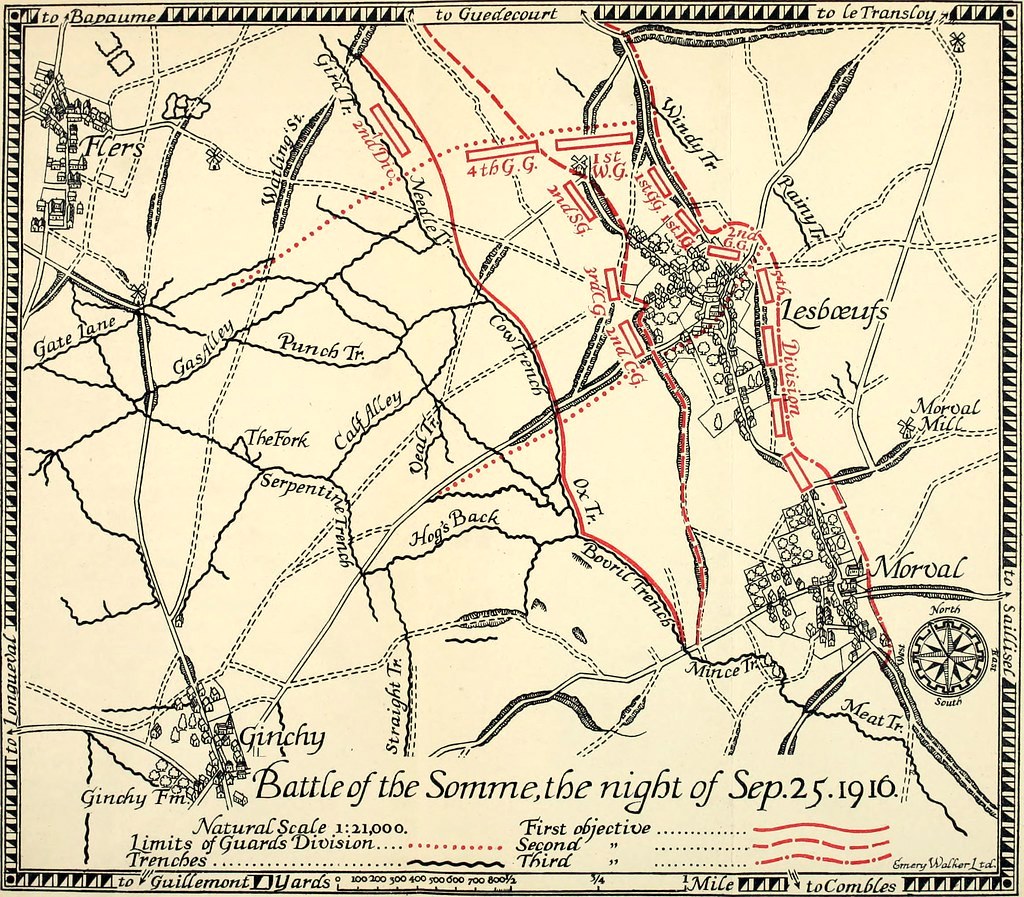
Guards Division on 25 Sept 1916 at the Battle of the Somme
The month of October was spent way out of the line, absorbing new reinforcements and training before moving back to ground west of Lesboeufs in mid-November. By this time the Battle of the Somme was coming to an end. At least the men would no longer have to leave their trenches to assault enemy positions. But that did not mean an end to casualties – enemy shellfire saw to that. Holding exposed shellhole positions joined up to make short sections of trenches, John’s battalion endured mud and tough conditions that the battle had created. Even getting to frontline positions meant miles of trudging along muddy paths and duckboard tracks. Safety, warmth and aid would have seemed a long way away.
Having contended with autumnal mud it was a horribly cold winter with temperatures falling to minus 20 Celsius for a six week period. One blessing of this plummet in temperatures was the mud froze, but so did water…and men. The main enemy at this point was the weather, not the Germans. In mid-March John was admitted to No.34 CCS for treatment of lumbago and “ICT feet”. Having endured such terrible trench conditions many men suffered problems with their feet. It is likely that John moved to a hospital in Rouen, thereby missing his battalion’s part in pursuing the Germans in their retreat to the Hindenburg Line. At some point he rejoined his battalion and moved northward to the Belgian city of Ypres. This was for the start of the Third Battle of Ypres (Passchendaele) during which the Guards Division attacked on the opening day, 31 July 1917.
And for the filming with David, this was as far as I got! I was asked to set the scene for John’s war up to this point. David went over to Ypres and was shown where his great grandfather was wounded. The records show John Boorman arrived back in the UK on 11 August 1917 having been wounded in the left leg below the knee. Despite escaping the horrors of the battlefield John’s war continued. In April 1918 he was admitted to hospital and found to be suffering from mental instability (delusional insanity). A few months after he was transferred to the County of Middlesex War Hospital which contained a specialist military mental hospital. Sadly, it appears John never recovered from the mental scars of service on the Western Front and died, still in care, in 1962. His is a tragic story that reminds us of the enduring effect that war had on many men. While some seemed to return to civvie life and get on with things, return to work, raise a family and function normally, other men were unable to do so and suffered mental anguish for the rest of their lives.
My thanks to the estimable Chris Baker of https://www.fourteeneighteen.co.uk/ who did so much of the research into John Boorman’s story and provided me with a copy of the report he had prepared for Wall to Wall.
JB
Following the success of the last three years of Bristol and West Country based battlefield tours organised with fellow historian, Clive Burlton, we are pleased to announce another trip for this coming autumn. This time our focus is not solely actions by units from the West Country but a look at associated stories of the postwar period of battlefield tourism and creation of Commonwealth War Graves Commission cemeteries.

Once again we are travelling with our partners at Bakers Dolphin. The three night, four day tour will visit key sites associated with the West Country. Travelling by executive coach we will depart from Bristol on 27 September and travel to Arras, stopping at sites of interest en route. If time permits we will visit Fresnoy near Arras where the 12th Gloucesters (Bristol’s Own) fought with heavy losses in May 1917.
The next day will be spent on the 1916 Somme battlefield with a look at the Bristol Territorials at Hebuterne and a visit to key battlefield sites including the Thiepval Memorial. On our way down to the Somme we aim to stop at Mory Abbey Military Cemetery to hear a most moving story of a father’s love for his son.
On 29 September we will journey northward to the sacred Ypres salient , the wartime cauldron for so many of Britain’s soldiers. Whilst in Ypres we will attend the Last Post ceremony at the Menin Gate and walk in the footsteps of the 1st Somerset Light Infantry in December 1914 at Ploegsteert (known as Plugstreet to the Tommies). Other key sites around the salient will be explored. Throughout the trip we will be looking at the work of the war artists such as Nash, Levinson and Orpen.
As ever, our tour is based around the stories of relatives of those who join us. Please do send us details and we will endeavour to visit individual graves and battlefield sites.
Accommodation is based at the following 3-star hotels – Holiday Inn Express (Arras) and the Novotel (Ypres). Full details of cost, what is included and contact details to reserve a space can be found on the attached flyer.
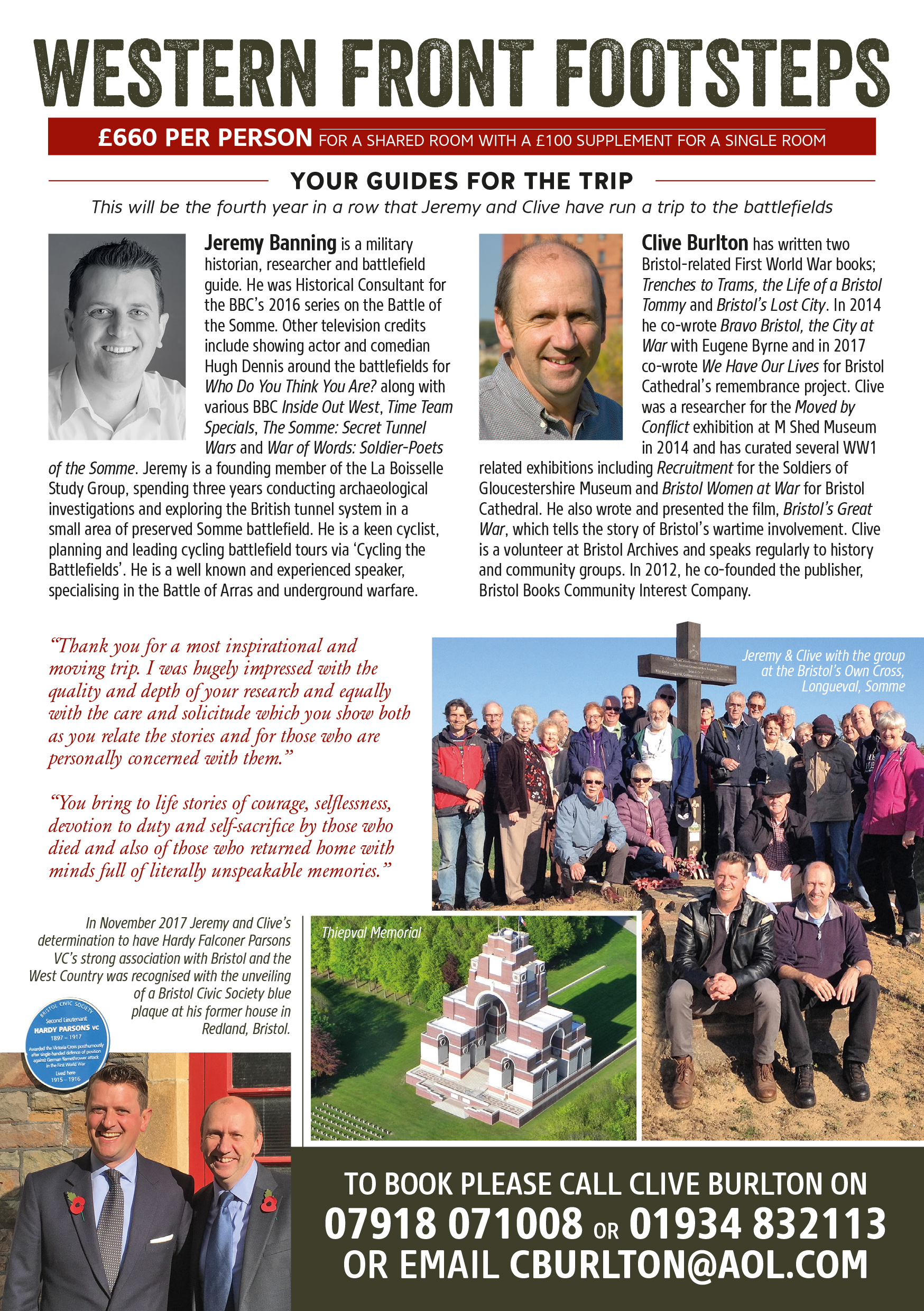
We look forward to you joining us for another wonderful few days following in some Western Front Footsteps…
 I recently spent a week at Shrewsbury International School in Bangkok giving talks and workshops to students. I last visited the school in 2013 and was heartened to view its continued growth and development over the past five years.
I recently spent a week at Shrewsbury International School in Bangkok giving talks and workshops to students. I last visited the school in 2013 and was heartened to view its continued growth and development over the past five years.
In the month prior to the armistice I worked in schools almost every day and have calculated that in that period I spoke to over 2,500 children. Most of these schools were local but I also spent two days at an international school in Toulouse. However, what I had planned for Shrewsbury was more ambitious.

History department – ready for Year 12 students and my talk on 1918
During my visit I spoke to children ranging in age from Year 6 to Year 13 (A-level). For Years 10 – 13 I was explaining how the Great War came to an end, the nature of open fighting on the Western Front and the deteriorating political and economic situation for the Central Powers. We also spent a lot of time focusing on the end of conflict and immediate post-war period during which soldiers were demobilised, returned home and picked up the pieces of their lives. Special focus was given to the psychological effect war had had on men and their reintegration back into civilian life. Whilst there was much focus on Britain I also spoke about the complex political and social feelings in Germany.
For 125 Year 9 students we had the ambitious plan of putting them into groups of six and letting them research the story of an individual soldier. I had chosen a dozen buy 500 tramadol soldiers that I had previously researched, all of whom had a fascinating story. A number had been killed in the war or died of wounds whilst others had survived into old age. A couple were underage (which always strikes a chord with school children), some were officers, one was Canadian, one Australian and all but one had a surviving service or pension record from which interesting information could be gleaned.

Papers with individual soldier’s details ready for Year 9 research workshop
After a demonstration of researching a soldier from me the groups started work. It was a lively and fun workshop with much running around by me from table to table! Having conducted research for an hour each group was asked to present their findings to the room. Undoubtedly the workshop brought home the war’s personal nature against the horrific impersonal casualty figures.
I also had sessions with Year 9 English students looking at the wartime service of Siegfried Sassoon and Wilfred Owen, two of the most famous war poets, and how their wartime experiences shaped their writing. Much of this was based on my research and work for the BBC’s War of Words: Soldier Poets of the Somme. This was topped off with a creative writing class where students created their own war poetry.
I am looking forward to working with Shrewsbury International School again and would like to thank Stuart Howard (History) and Victoria Rotheram (English) for their assistance during my visit.

View down the Chao Phraya river with Shrewsbury International School in the foreground
New Battlefield Tour announced! ‘Western Front Footsteps’ 28 September – 1 October 2018
Following the success of 2016’s ‘Bristol on the Western Front’ and last year’s ‘The West Country at War’ tour trip that I organised with fellow historian, Clive Burlton, we are pleased to announce another trip for this coming autumn.
Stops will cover actions by units from Wiltshire, Somerset and South Wales as well as Bristol. The tour is named ‘Western Front Footsteps’.
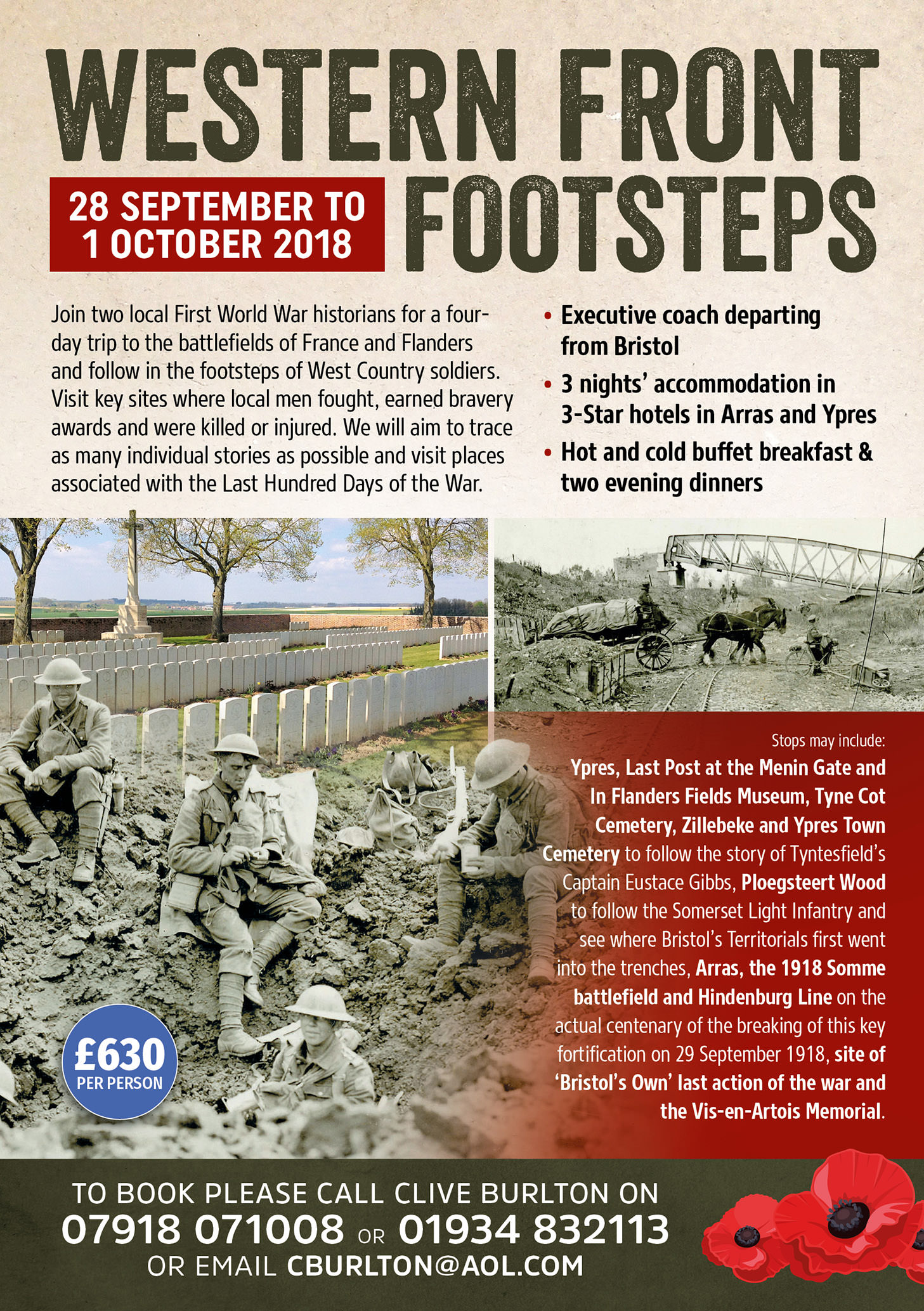
Once again we are travelling with our partners at Bakers Dolphin. The three night, four day tour will visit key sites where soldiers from the West Country fought, earned bravery awards and lost their lives.
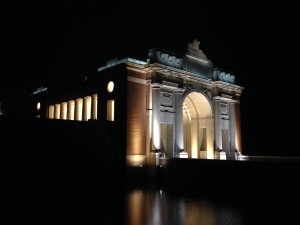
Menin Gate, Ypres
Travelling by executive coach we will depart from Bristol on 28 September and travel to Arras, stopping at sites of interest en route. The next day will be spent on the 1918 Somme battlefield on the centenary of the breaking of the Hindenburg Line – a momentous day that paved the way to allied victory. It is also the centenary of the last assault ever made by the 12th Gloucesters (Bristol’s Own) and we will walk their final attack. It will be special to visit this fascinating battlefield on such a poignant day.
On 30 September we will journey northward to the sacred Ypres salient , the wartime cauldron for so many of Britain’s soldiers. Whilst in Ypres we will attend the Last Post ceremony at the Menin Gate and visit the In Flanders Fields Museum in the Cloth Hall. Our time in Ypres will see us visiting sites around the salient including Ploegsteert (known as Plugstreet to the Tommies) to follow the 1st Somerset Light Infantry in December 1914, see where the Christmas Truce took place and visit the area in which Bristol’s Territorials first went into the trenches.

A key theme of this year’s tour will be looking into the wartime history of the Gibbs family from Tyntesfield (now a National Trust property) – their story is fascinating and heart-rending.

Ypres Cloth Hall – now the location for the In Flanders Fields Museum
Accommodation is based at the following 3-star hotels – Holiday Inn Express (Arras) and the Novotel (Ypres). Full details of cost, what is included and contact details to reserve a space can be found on the attached flyer.
We look forward to you joining us for another wonderful few days following in some Western Front Footsteps!
‘Remembering Reading’s Heroes’ – a talk at Haslams Estate Agents for Reading FC and ABF The Soldiers’ Charity
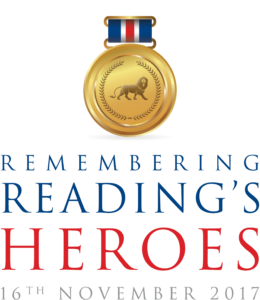
Last week I gave a talk on behalf of Haslams Estate Agents and Reading Football Club in Haslams’ flagship office in Friar Street, Reading. The talk was part of a fundraising evening for ABF The Soldiers’ Charity and was attended by over 80 people.
The evening started with drinks and canapés (based on wartime fare which included such things as spam fritters and Maconochie’s steak pies) before 25 minutes from me discussing Reading in the Great War.

Canapés were based on a wartime theme
Most of the audience had little knowledge of this period of history and I was able to explain some of the more interesting stories I had found in my research. These included the story of Max Seeberg, a former Reading FC player from the 1912–13 season who, by the time was declared in August 1914, had retired and was working as a publican. Despite being a well-known and liked member of Reading’s community his German ancestry ensured he was locked up for the duration of the war. Remarkably, he seemed to bear no malice to Britain, becoming a naturalised British subject in 1920.

Talking about Max Seeburg, a former Reading FC player who was locked up for the duration of the war due to his German nationality
I also spoke about Ronnie Poulton Palmer, the England rugby player, Trooper Fred Potts VC and the tragic case of the Sutton family (of Sutton Seeds) whose five boys went off to war. By the end of March 1918 four of them had been killed, leaving Leonard Sutton (a wartime mayor of Reading) with his sole remaining son, Noel who survived the conflict despite being torpedoed mid-channel by a German U-Boat.
After a break for more drinks and canapés an auction and raffle was held. A weekend on the battlefield with me was auctioned off by local resident, Chris Tarrant. Over £3,000 was raised for ABF The Soldiers’ Charity.
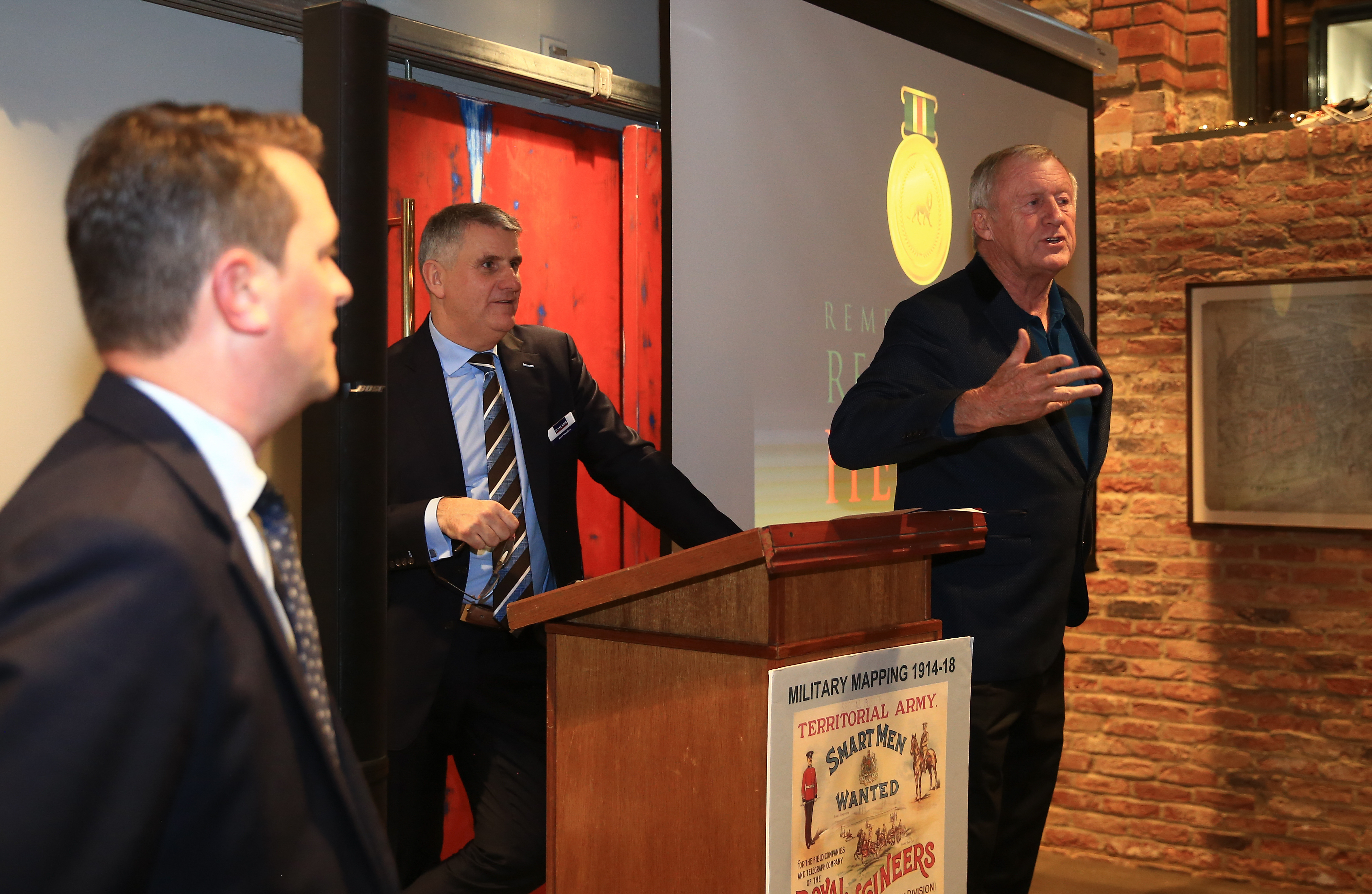
Chris Tarrant auctions a weekend on the battlefield with me to raise funds for ABF The Soldiers’ Charity
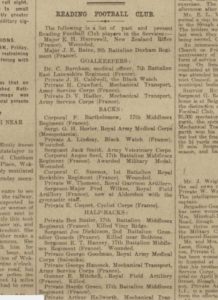
An extract from the Reading Mercury of 12 August 1916 listing players associated with Reading Football Club serving in the forces
The second half of my talk focused on telling the story of a number of Reading FC players and their wartime service. Nine former players died in the conflict whilst others such as Joe ‘Bubbles’ Bailey achieved remarkable success as a fighting officer. In Joe’s case this resulted in the award of the DSO and three Military Crosses, all in a period of just seven months in 1918!
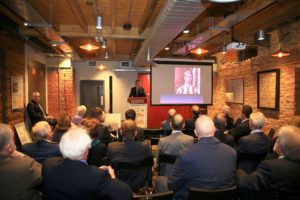
Speaking about Joe Dickenson, ‘the Footballing Grenadier’ who served in the 2nd Grenadier Guards and was killed at the Battle of Festubert in May 1915
My thanks to BBC Radio Berkshire’s Graham McKechnie, military historian Jon Cooksey and Reading FC historian Alan Sedunary who conducted a great deal of research on these players back in 2014.
The entire evening was a great success and I look forward to working with Haslams and Reading FC again in the future.
A selection of images from the evening (courtesy of Ben Hoskins http://www.bhoskins.com/) are shown below.
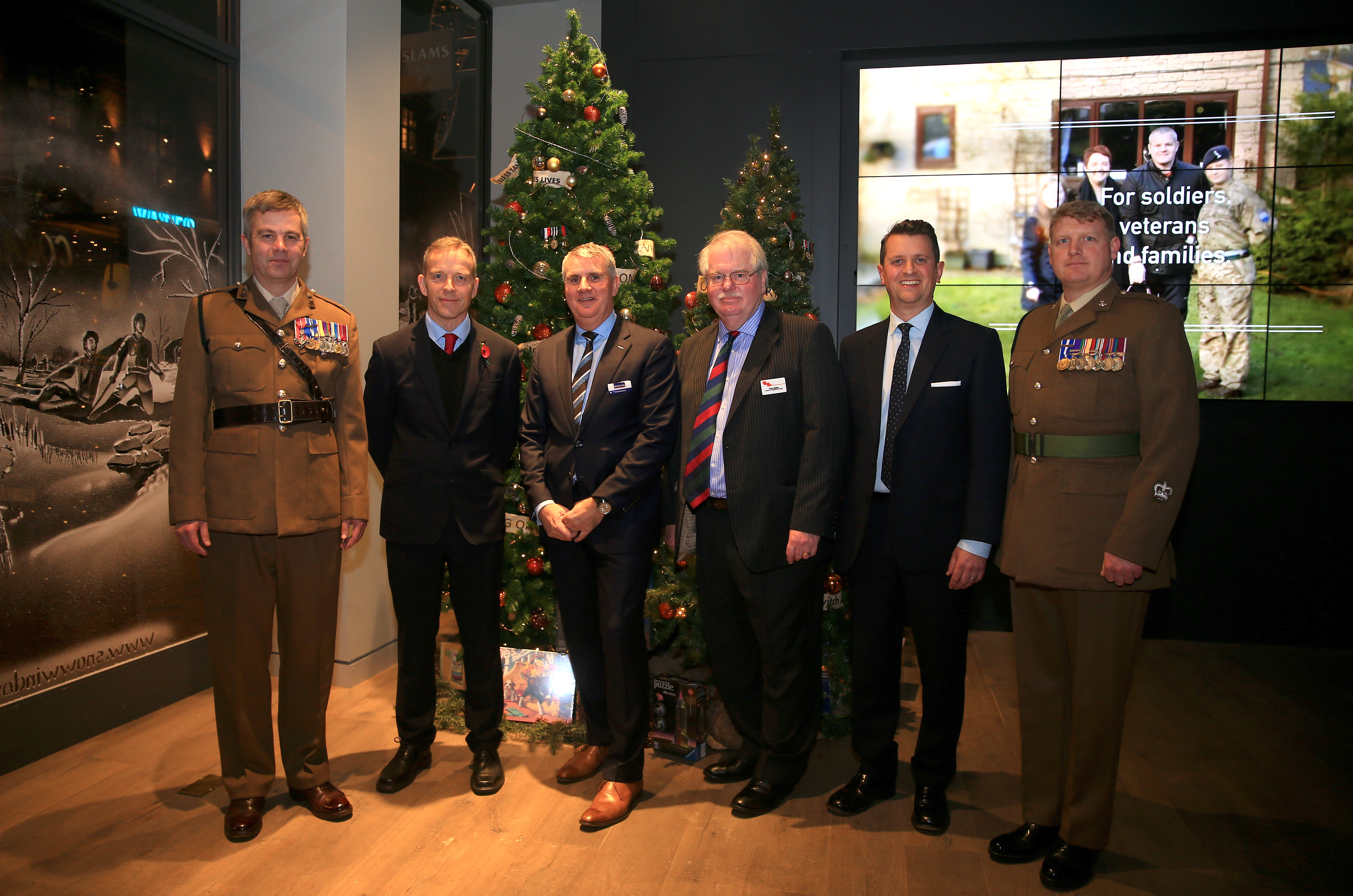
With Steve Woodford of Haslams, Brigadier Peter Walker of ABF The Soldiers Charity and serving soldiers
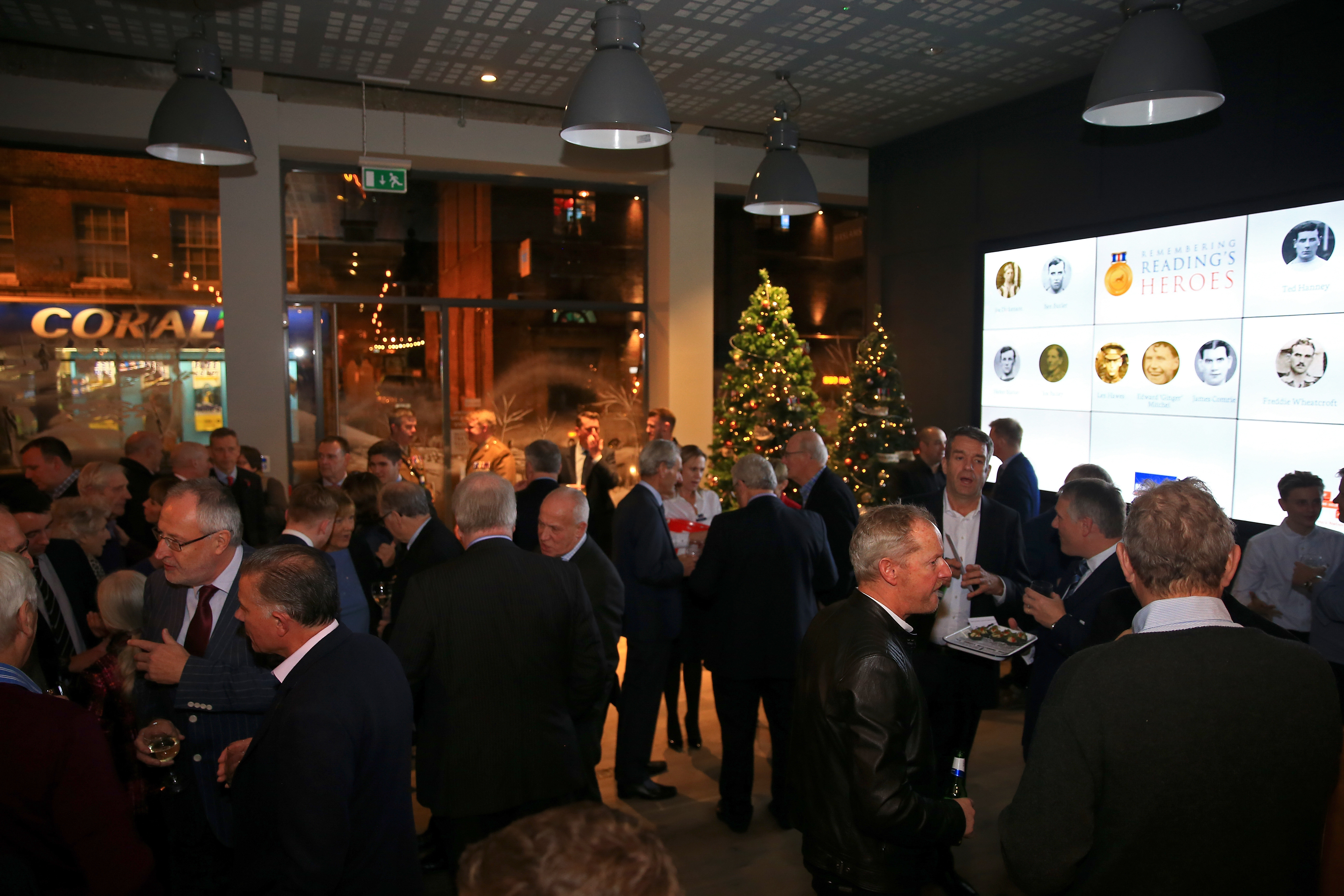
Pre-talk drinks and canapés
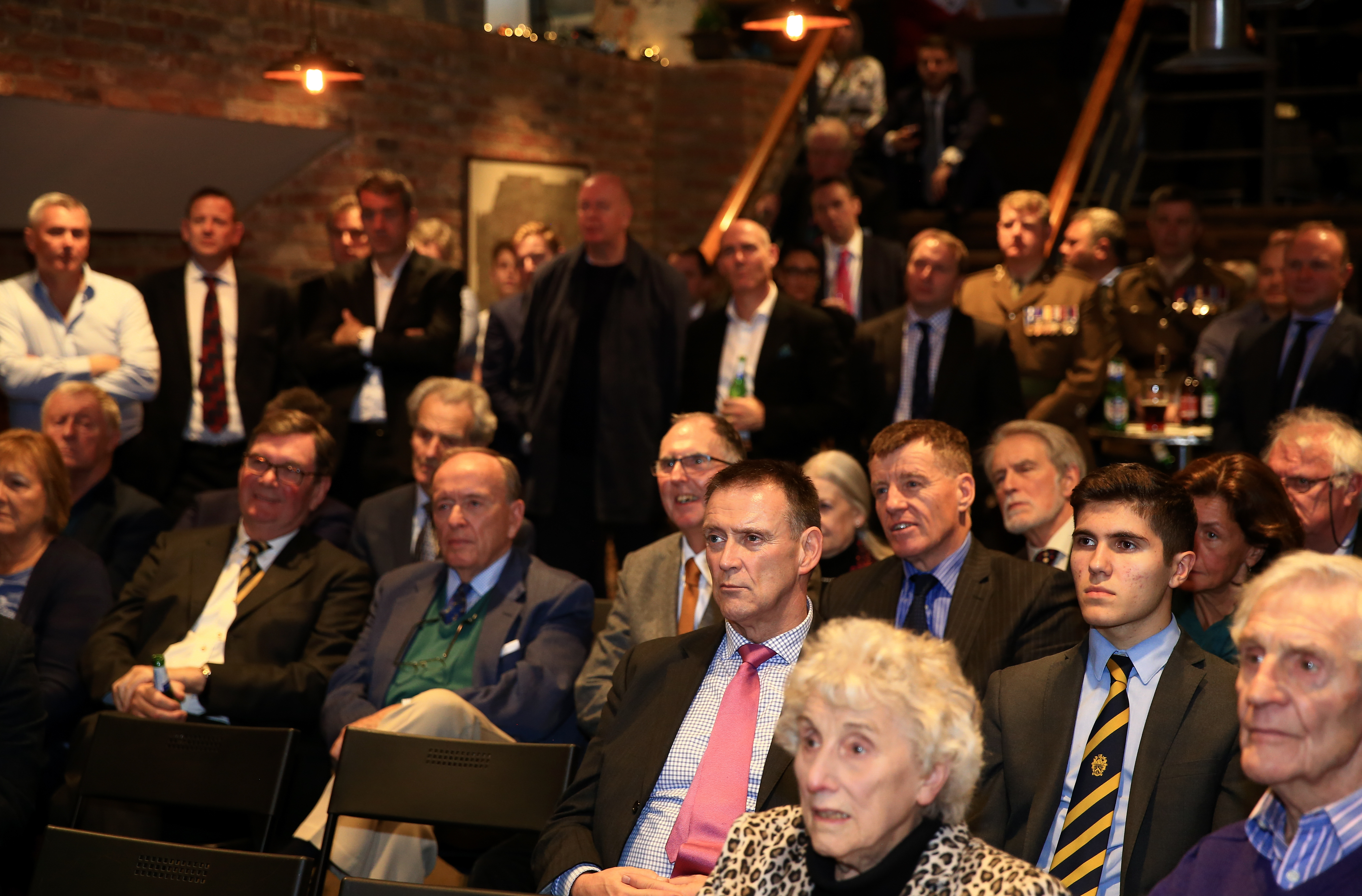
The audience seemed to enjoy the talk
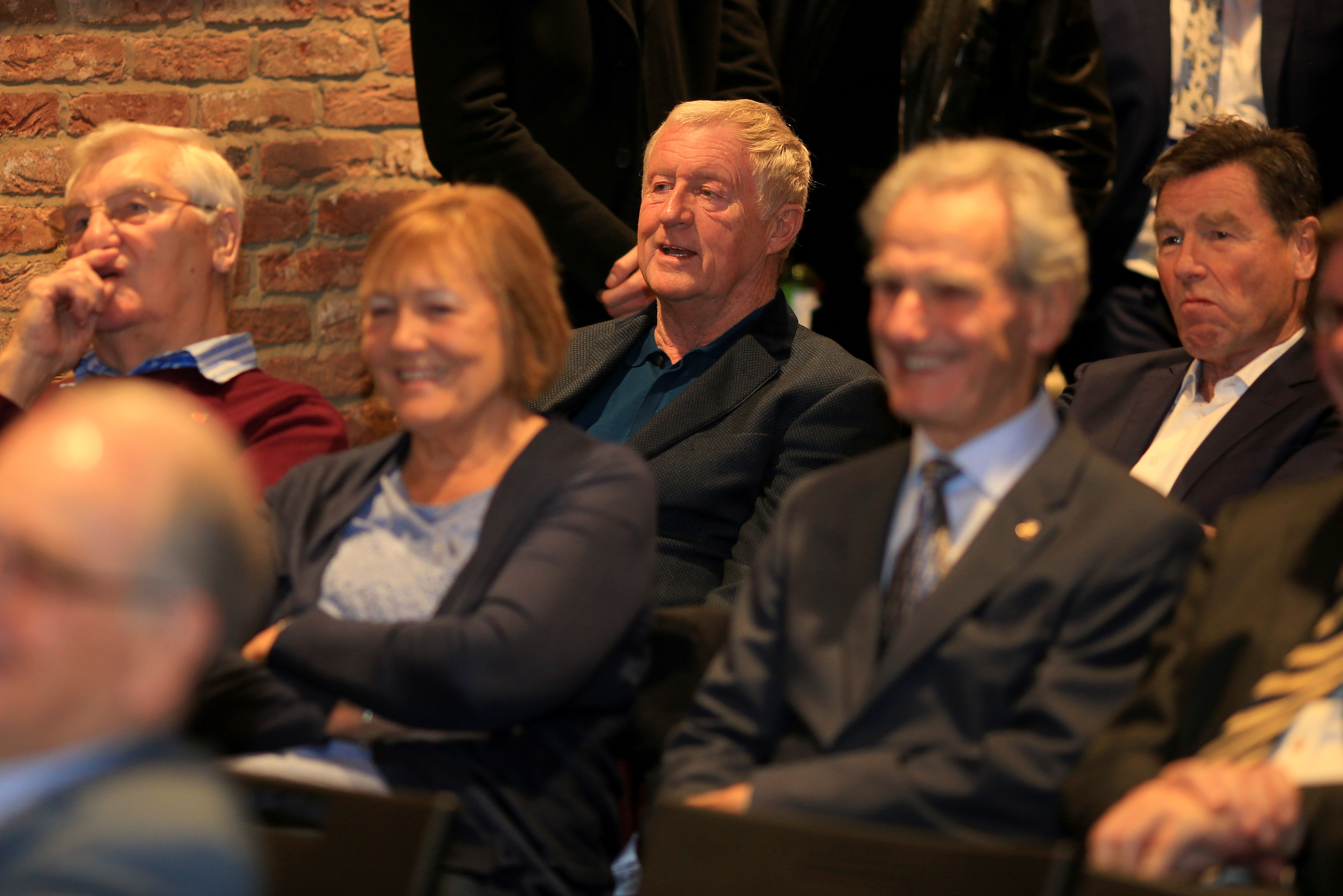
More audience shots
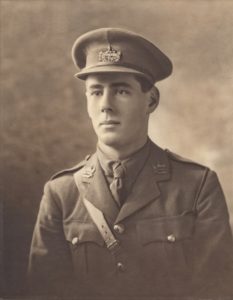
Second Lieutenant Hardy Falconer Parsons VC, 14th Gloucestershire Regiment. Image courtesy Soldiers of Gloucestershire Museum, Ref GLRRM:04750.6
Today saw the unveiling of a Bristol Civic Society blue plaque at the former Bristol home of my local Victoria Cross recipient, 2/Lt Hardy Falconer Parsons VC, 14th Gloucestershire Regiment. He lived a fifteen minute walk from my house and I have known his story for the past fourteen years that I have lived in the city.
My colleague Clive Burlton and I were determined to see Hardy’s strong association with Bristol and the West Country recognised. As his Government funded VC commemorative stone was unveiled in Rishton, Lancashire back in August we have spent the last year working on honouring Hardy’s local connections with a Bristol Civic Society blue plaque.
The plaque was unveiled by the Archie Smith and Grace Tyrrell, Head Boy and Head Girl of Kingswood School along with the Lord Mayor of Bristol, Cllr Lesley Alexander. The ceremony was attended by members of the Bristol Civic Society; the former Gloucestershire Regiment; the Soldiers of Gloucestershire Museum; the Bristol University Officer Training Corps; Kingswood School, Bath, Redland Green School and Dolphin Schools in Bristol; bandsmen from the Salamanca Band of the Rifles Regiment; members of the Western Front Association and the Bristol Great War network and representatives of the Kingswood Association, whose generous donation enabled the plaque to be made and installed. Also attending were the Deputy Lord-Lieutenant for the County and City of Bristol, Colonel Andrew Flint and the Dean of Bristol, the Very Rev Dr David Hoyle. In total, around 100 people were in attendance for the ceremony. Afterwards a sizeable number of us were invited back to the Artillery Grounds on Whiteladies Road for light refreshments as guests of Bristol University Officer Training Corps.
Images of the unveiling ceremony can found below, followed by the culmination of much detailed research into Hardy’s life by Clive Burlton and myself. I can only hope that the people of Bristol and Bath embrace his memory. He deserves that.
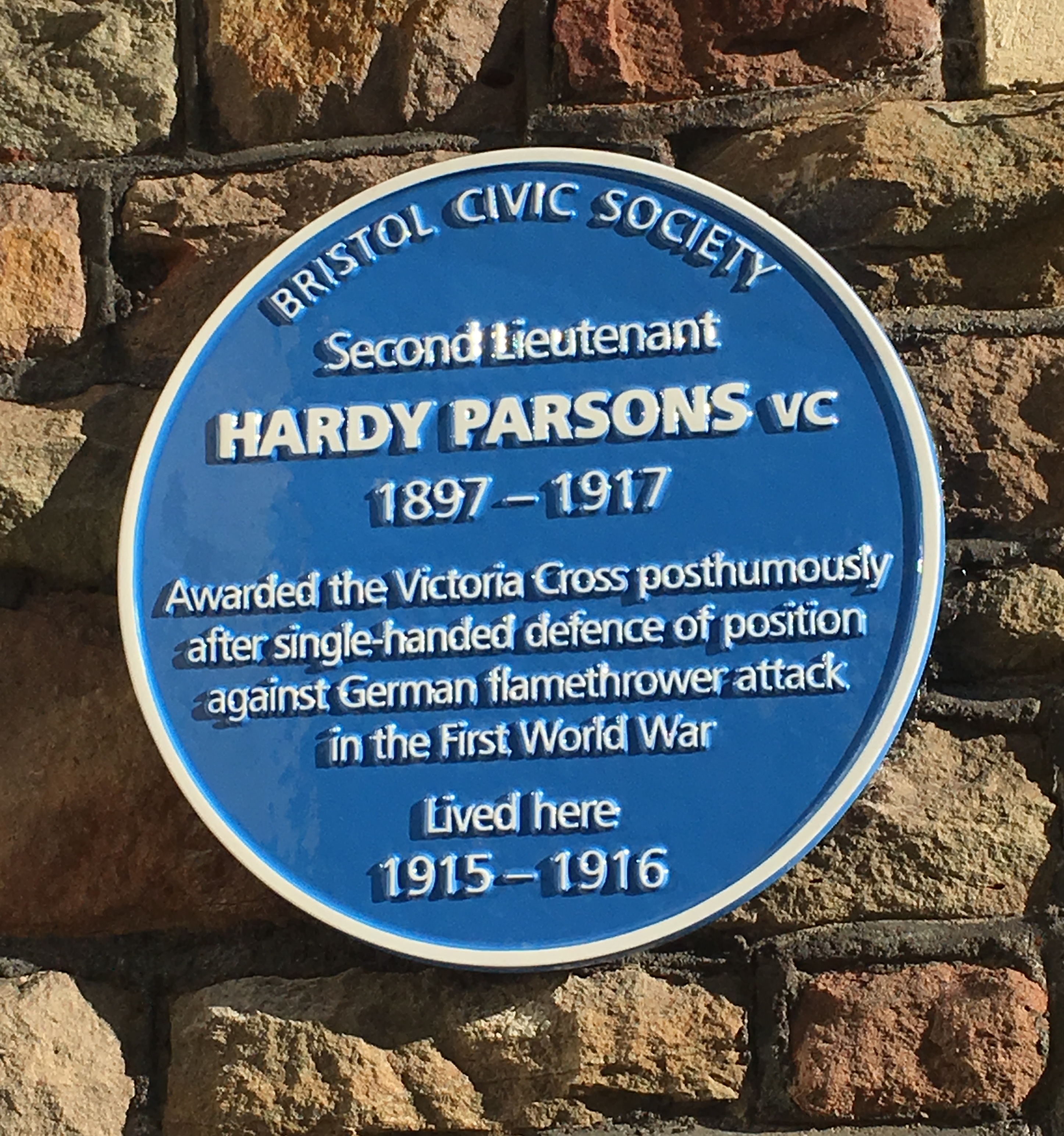
Blue plaque for Hardy Falconer Parsons VC at 54, Salisbury Road, Redland, Bristol
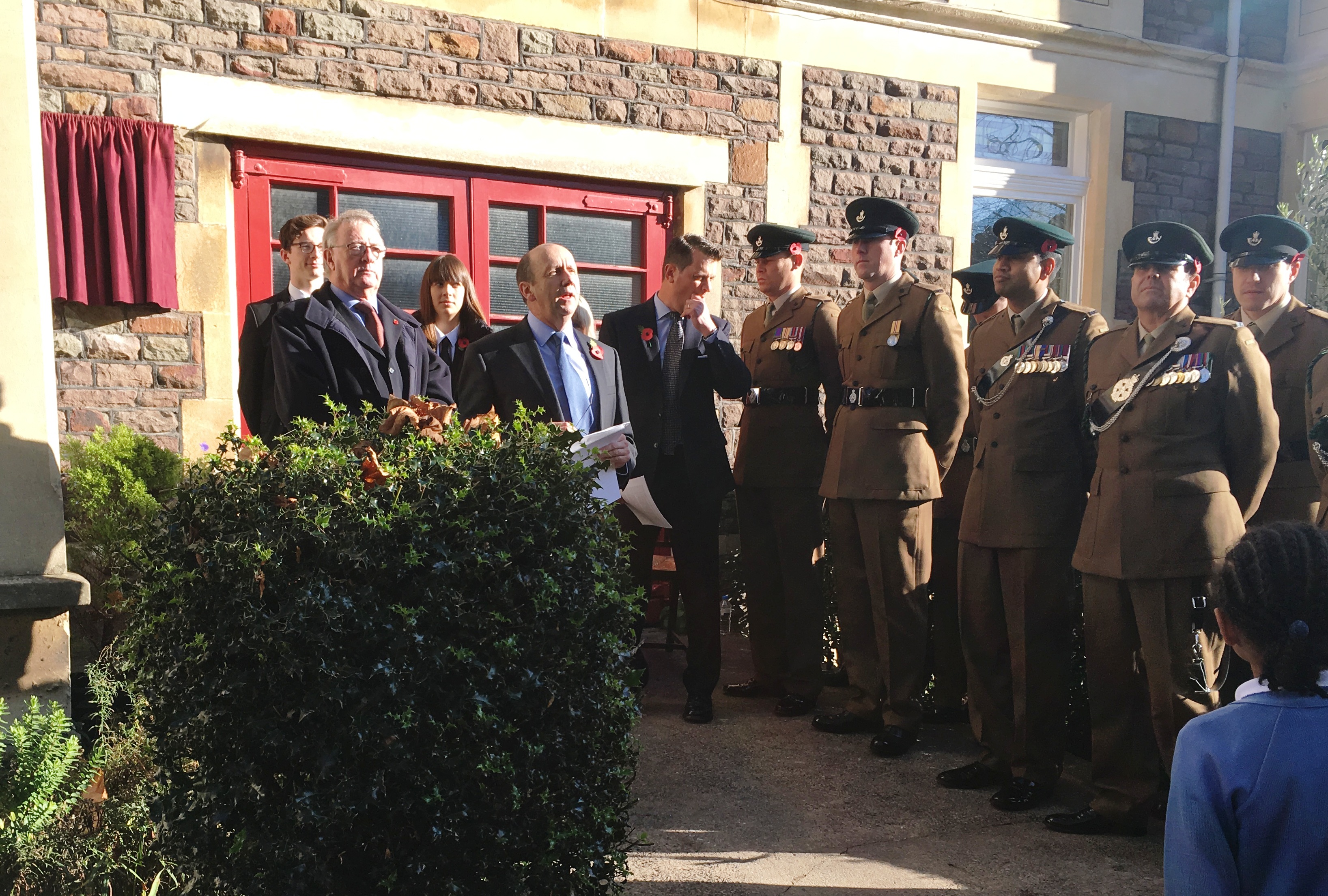
Clive Burlton gives the opening address
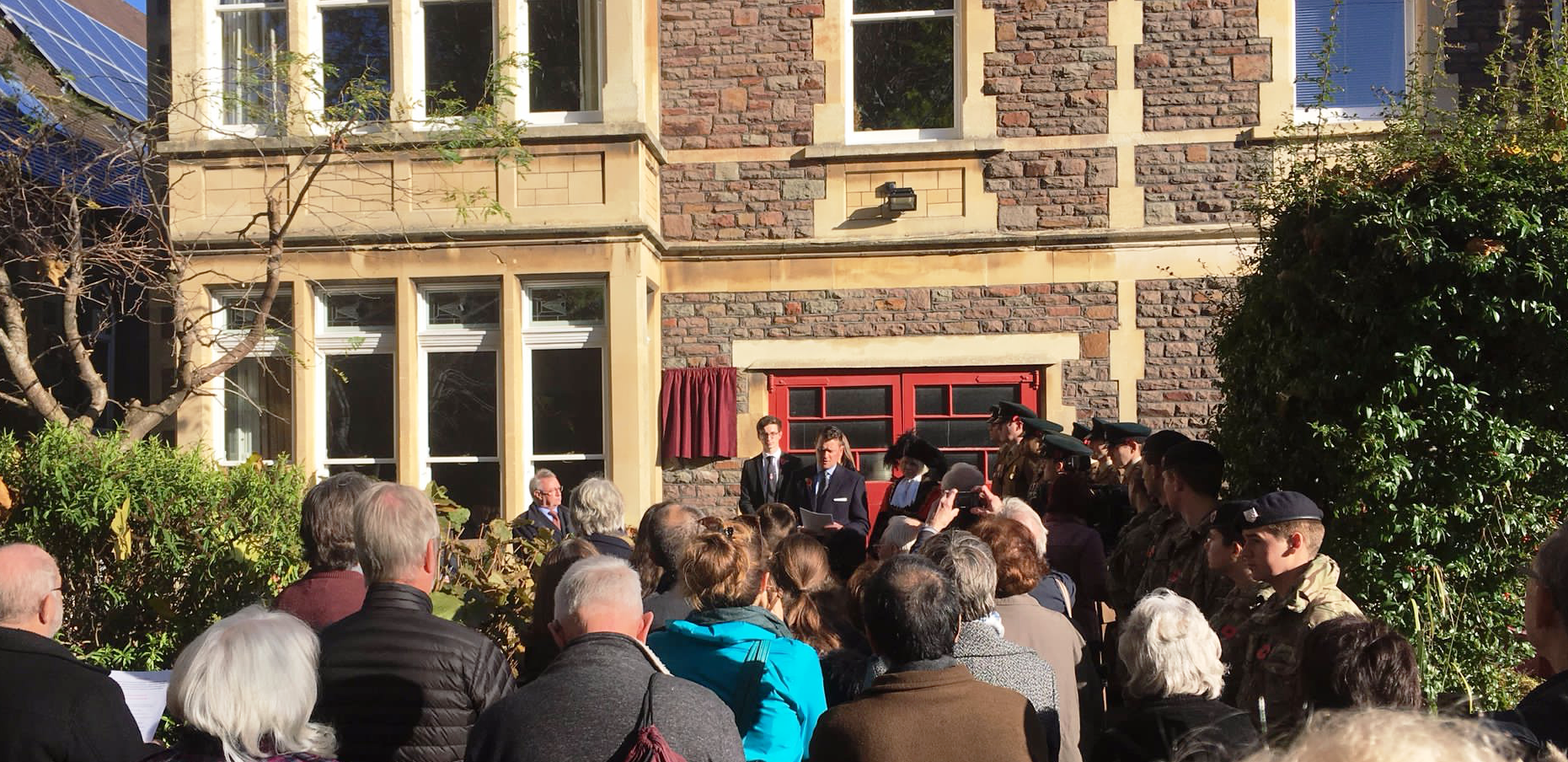
Jeremy Banning providing the historical background to the life of Hardy Falconer Parsons VC
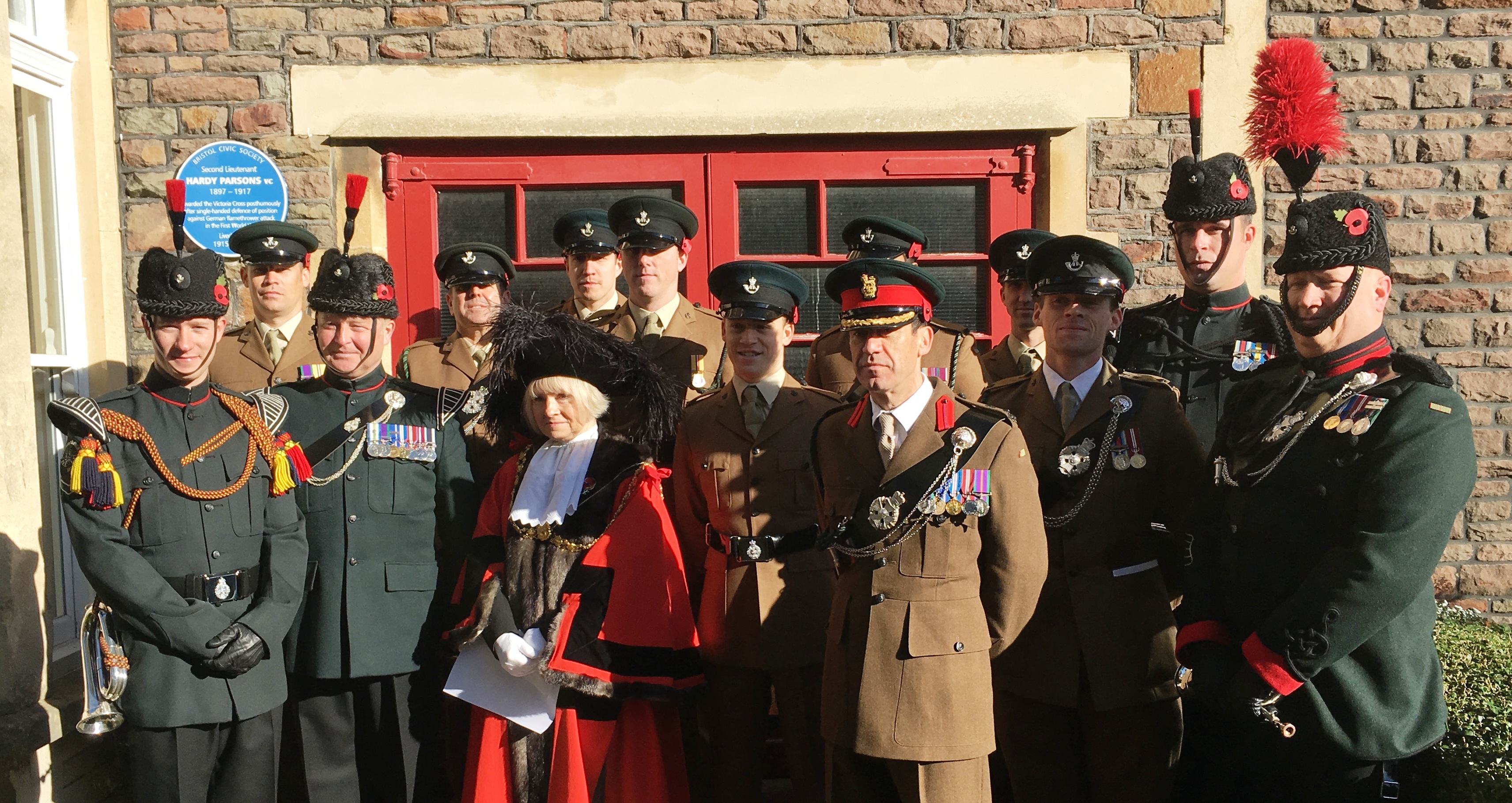
The Lord Mayor of Bristol with members of Bristol University Officer Training Corps and bandsmen from the Salamanca Band of the Rifles
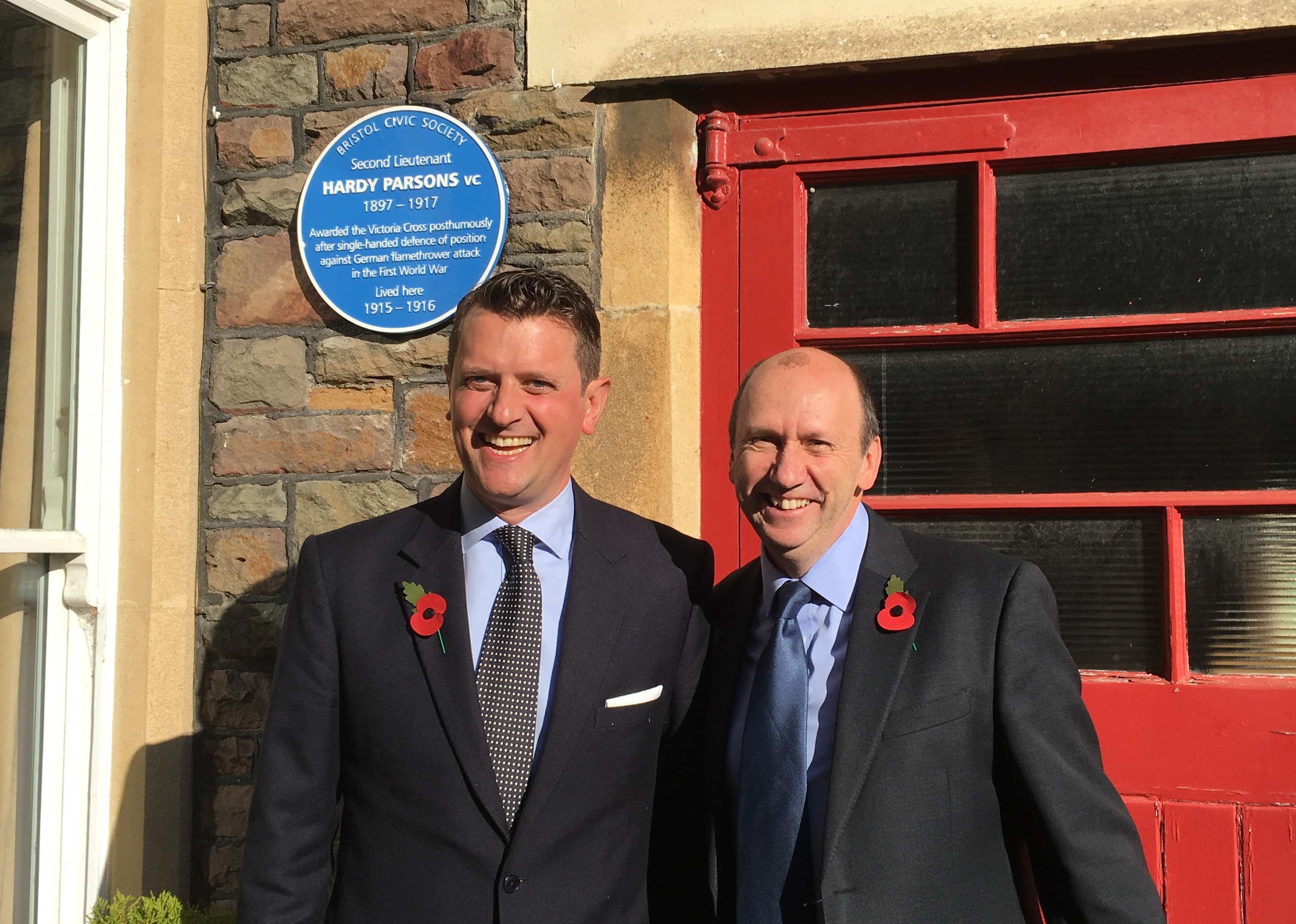
A delighted Jeremy Banning and Clive Burlton with Hardy’s new blue plaque
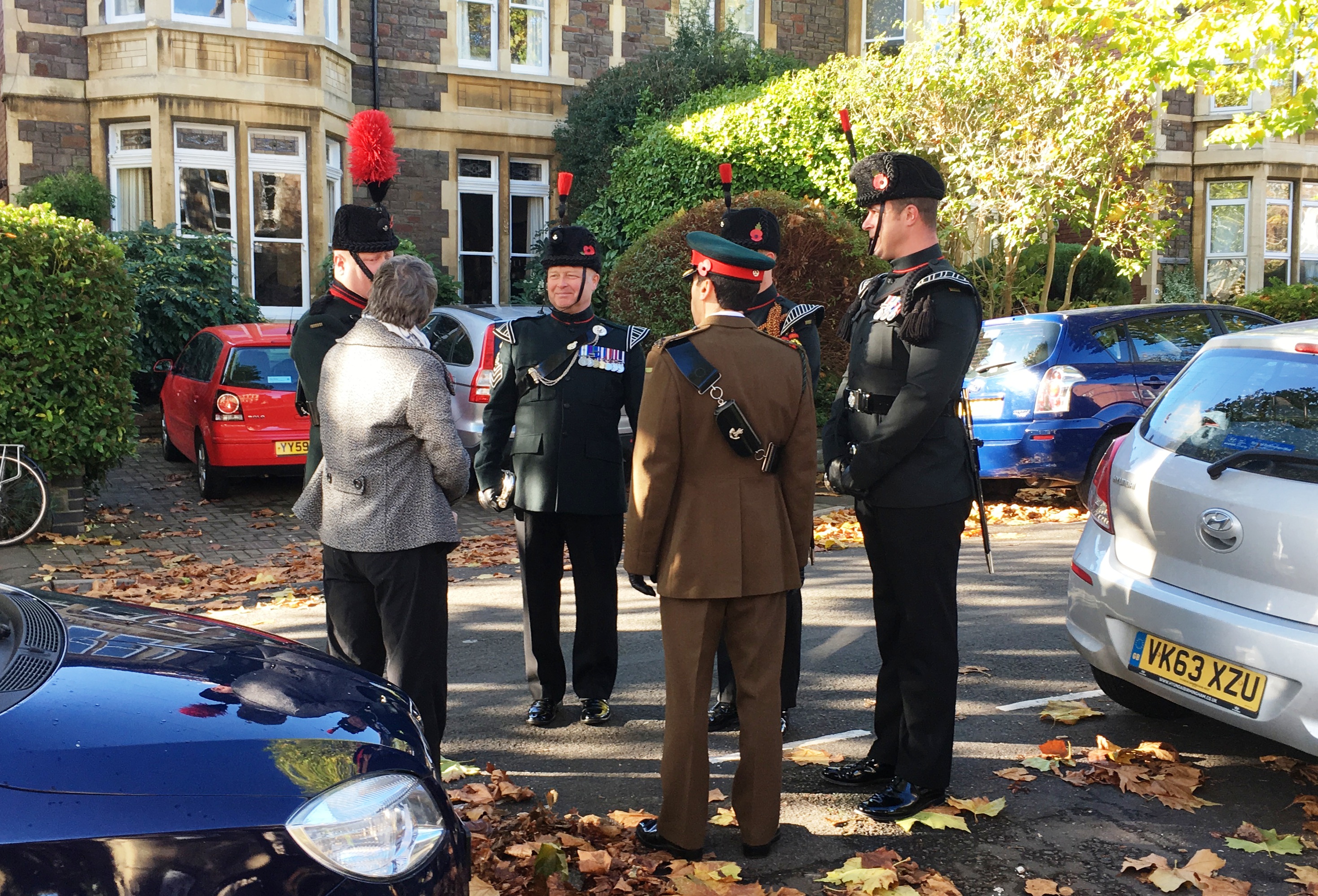
The ceremony was well attended by the military
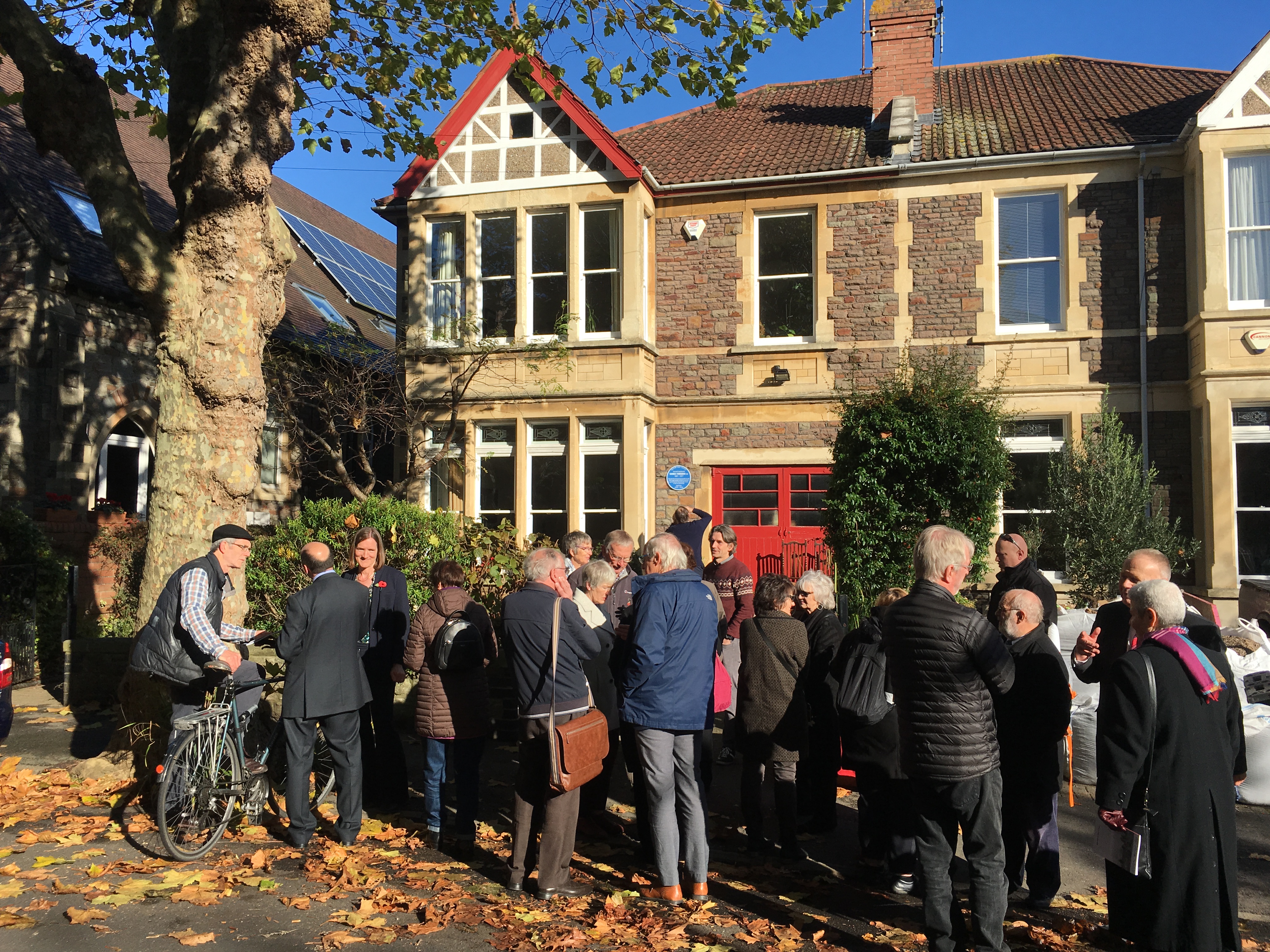
After the ceremony many of those attended were able to mingle and discuss Hardy’s life
Bristol 24/7 have also covered the story: https://www.bristol247.com/news-and-features/news/pictures-blue-plaque-revealed-wwi-soldier-redland/ as have BBC News: http://www.bbc.co.uk/news/uk-england-bristol-41918314. Our BBC Points West interview is available for a week from 16 minutes in here: https://www.bbc.co.uk/iplayer/episode/b09bzw5f/points-west-evening-news-08112017
The life of Hardy Falconer Parsons VC, 14th Battalion, Gloucestershire Regiment
Hardy Falconer Parsons was born on 30 June 1897 at Rishton, near Blackburn, Lancashire, the first of three boys. His father, the Rev James Ash Parsons, was a Wesleyan Minister whilst his mother Henrietta (known as Rita) was the daughter of a railway inspector from York. Hardy’s rather unusual middle name came from Rita – Falconer was her maiden name.
The Rev James Ash Parsons had spent eleven years in total in the slums of East London as superintendent of the Methodist Leysian Mission. Ill health forced him and Rita to St Anne’s on Sea, south of Blackpool and it was whilst living here that Hardy was born. There followed three years at Arnside immediately south of the Lake District. Clearly, the ethos of duty and service to others, so well practiced by his parents, was a huge part of Hardy’s upbringing.
Hardy’s first school was King Edward VII School at Lytham St Annes. From the paper work we have found it appears the family moved to Bristol in 1912 when the Rev James Ash Parsons became pastor at the Old King Street Wesleyan Chapel (sadly, now demolished). The family moved to 54 Salisbury Road in Redland and Hardy attended Kingswood School in Bath until April 1915.
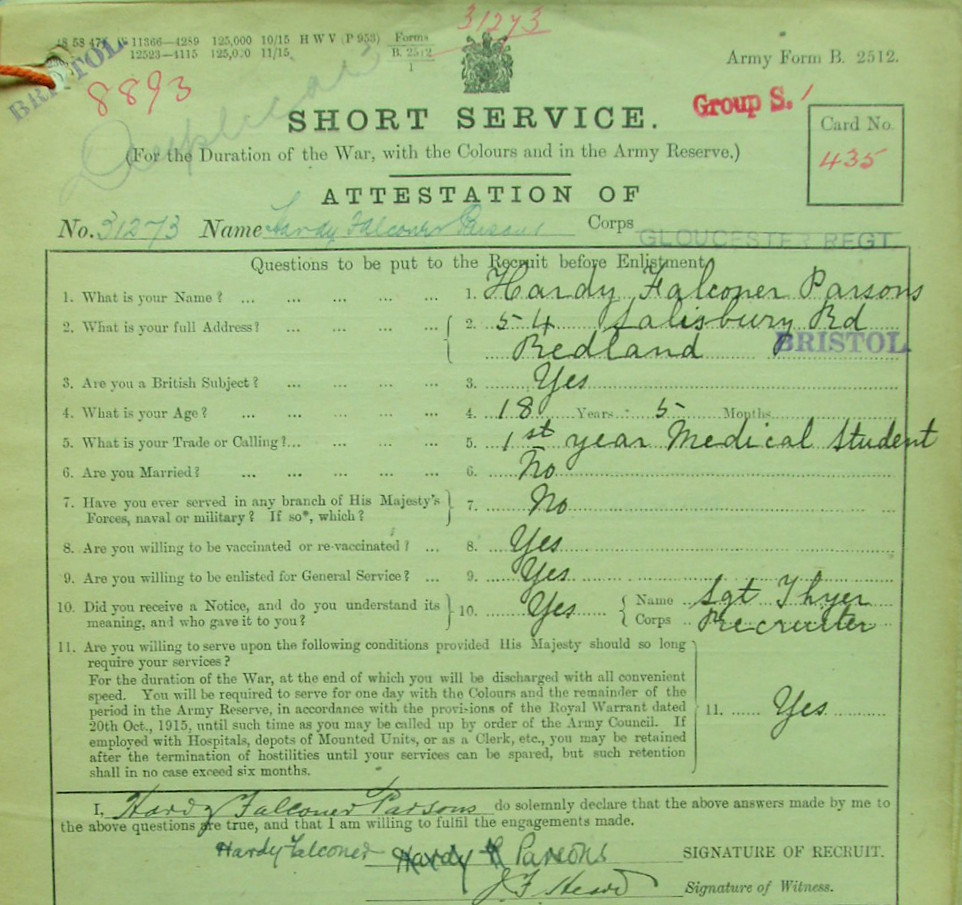
Extract from attestation papers of Hardy Falconer Parsons (National Archives: WO339/73298)
After school Hardy Parsons became a Medical Student at Bristol University with the aim of becoming a medical missionary. At the end of November 1915, during his first year at the University he signalled his wish to volunteer for service by attesting when aged just 18 years & 5 months but was immediately placed on the Army Reserve.
He had previously declined a safe post in a Government munitions laboratory, feeling that he ought not to withhold himself from the fullest sacrifice. He hated war, but recognised that the making of munitions was just as much war work as was the actual taking of life.
He joined the University’s Officer Training Corps in May 1916, a month shy of his 19th birthday, and then passed his first Bachelor of Medicine degree. His attestation papers make interesting reading – recording that he was a tall man, especially for that time, standing at 6ft ¾ inch tall. In early October 1916 he was posted to 6th Officer Cadet Battalion at Balliol College, Oxford and, on 25 January 1917, was appointed to the Gloucestershire Regiment as a Second Lieutenant.
He eventually joined the 14th Battalion in March, a unit which had previously been a ‘Bantam’ battalion – with men of 5ft 3 inches and less serving in its ranks. By the time the nearly 6ft 1 inch Hardy joined the battalion this unique distinction had been very much diluted. In February 1917 the battalion war diary records 475 ‘normal size men’ joining the battalion.
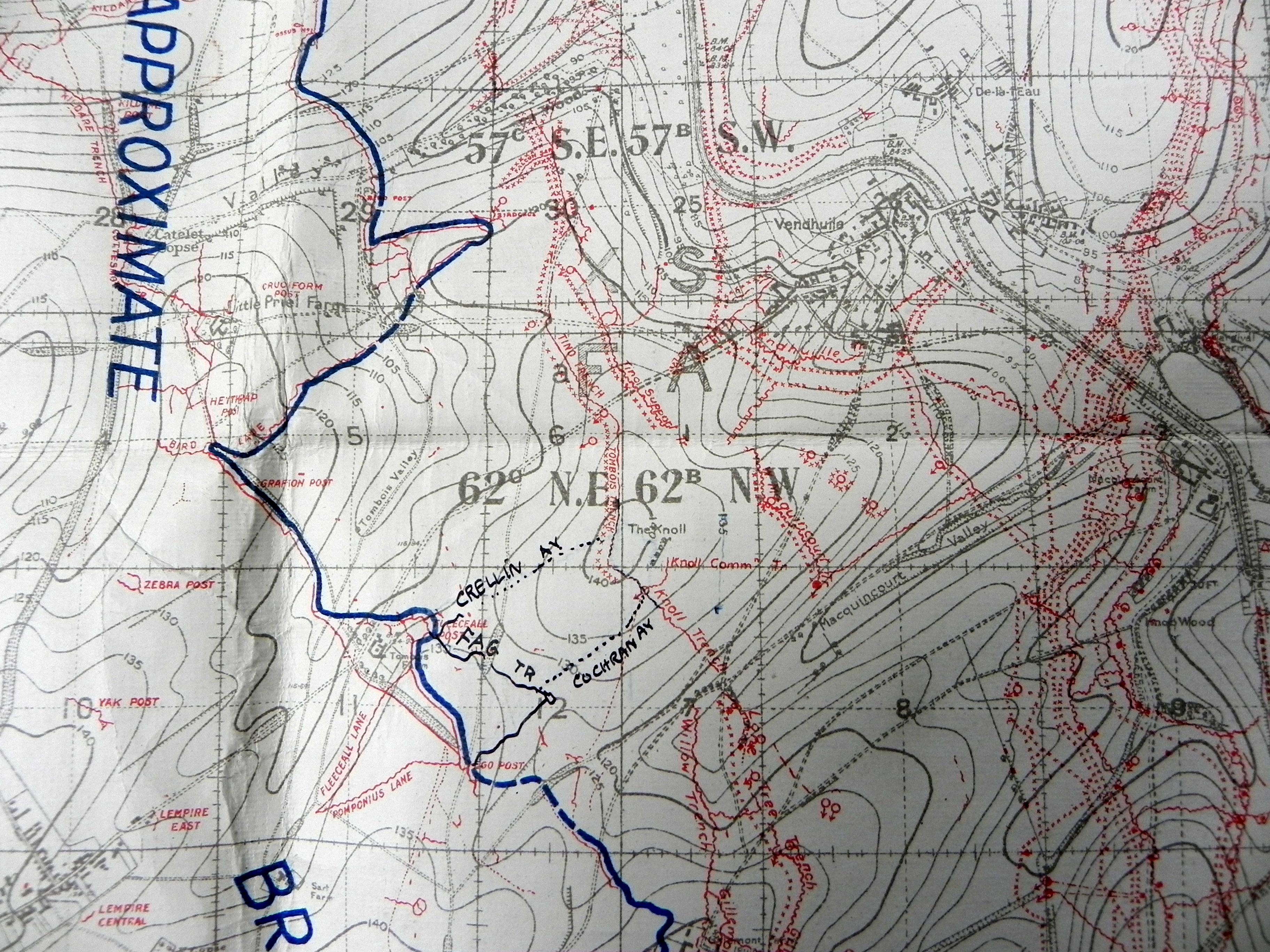
Trench map extract of The Knoll – captured by 105 Infantry Brigade on 19 August 1917
On 21 August 1917 near the village of Vendhuile in the eastern part of the Somme, Hardy’s battalion were holding recently captured trenches at a position known as The Knoll in the Hindenburg Line outpost zone. Their relief of the units who had captured the Knoll some two days before was completed by 1.30am that night.
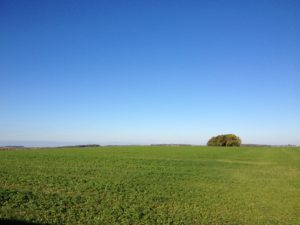
Modern view of The Knoll, photographed October 2017. Vendhuile, the Hindenburg Line and St Quentin Canal are out of view in the valley.
It was a critical position which afforded observation over the Hindenburg Line and St Quentin canal a mile away – observation the British wanted and the Germans wanted to prevent. In fact, men from Bristol’s 1/4th and 1/6th Territorial battalions had fought for the same view in this same position four months previously.
The loss of such critical terrain forced the Germans into a devastating counter-attack. As recorded in the Brigade war diary, at 3.51am the Germans struck. Militarily, it was a brilliantly executed counter-attack by the Germans – The Knoll being attacked at four points simultaneously. German infantry were accompanied by special detachments using portable flamethrowers. These forced Hardy Parsons’ men back. However, he alone stuck to his bombing post and held his position, throwing bombs (hand grenades) at approaching Germans until a British counter-attack could be launched. The counter-attack was successful – the Germans were repulsed from the trenches around The Knoll and within 40 minutes this bloody action was over. Much of this success is due to Hardy’s refusal to yield ground.
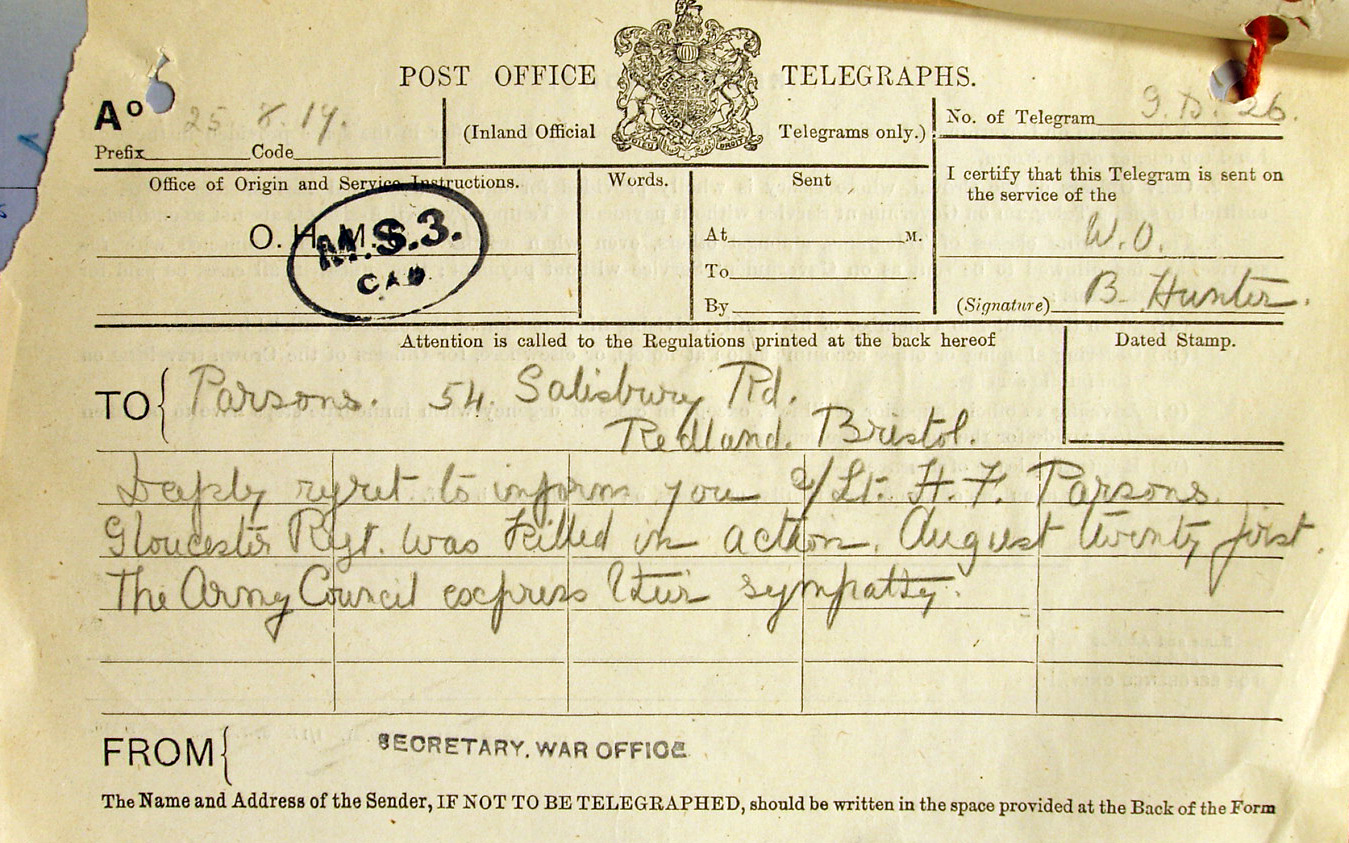
Telegram sent to the Rev James Ash Parsons informing him of Hardy’s death
During his heroic sole defence of The Knoll Hardy had been severely burnt by liquid fire. Writing these words over a hundred years later I cannot begin to imagine the sense of duty that compelled him to stay at his post, or the pain he would have endured during and after sustaining such horrific burns. Unsurprisingly, the nature of his wounds proved too severe and he succumbed later that day, dying at the age of just 20 years and two months. Hardy Falconer Parsons is buried in the immaculate CWGC cemetery at Villers-Faucon.
N.B. I was contacted in August 2019 by Dr Markus Schroeder whose great great uncle, Ernst Komander, served with the 2./Jäger 6, Jäger-Regiment 6, 195 Infanterie-Division. He tells me that regimental records show it was Jäger-Regiment 6 that led the attack on the 14th Gloucesters with the specialist flamethrowers employed by Sturmbataillon 3. Ernst Komander was wounded on the day of the attack and died of those wounds two days later. He is buried in Block 2, Grave 56 in Caudry German Military Cemetery.
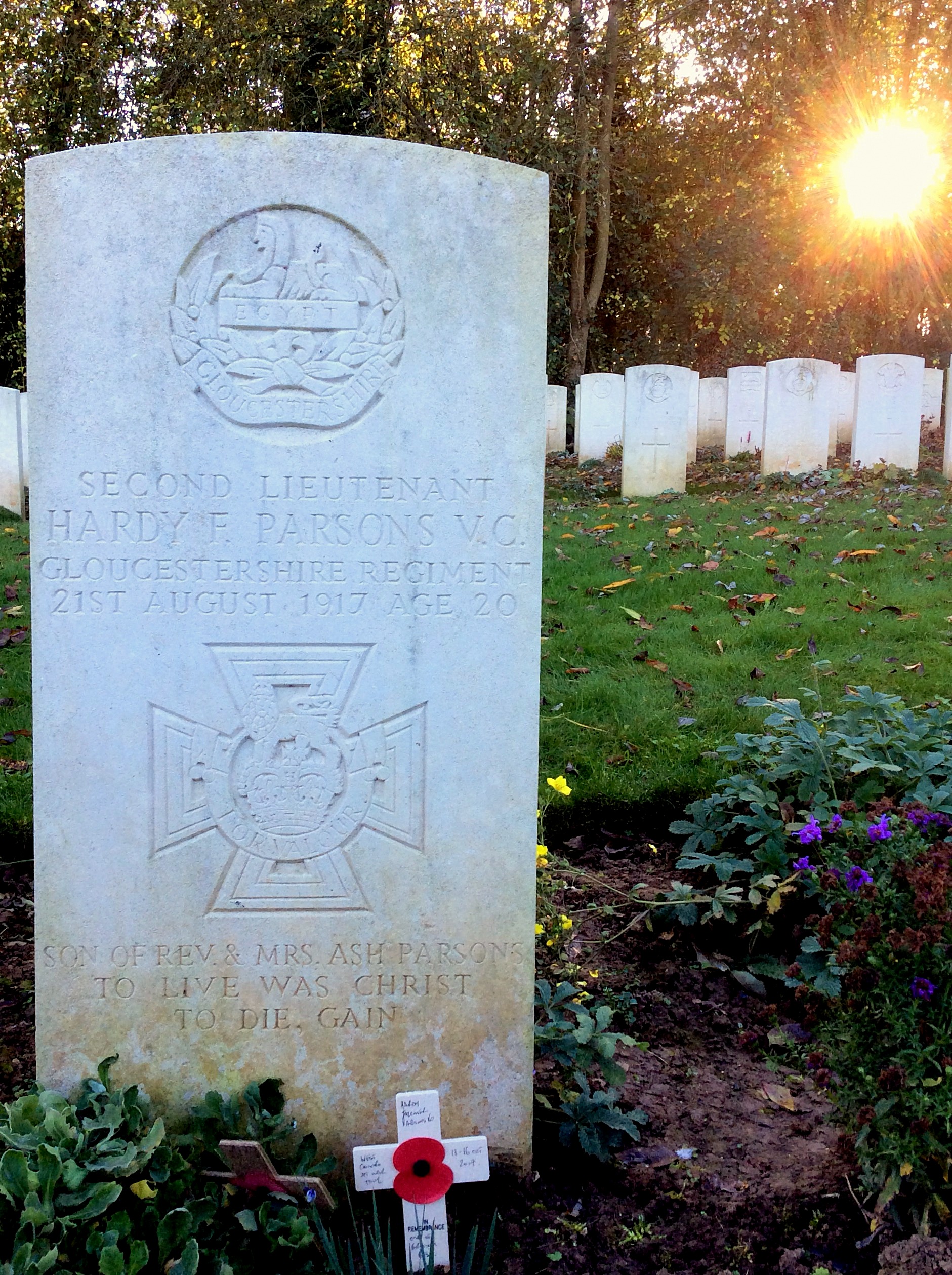
Grave of Hardy Falconer Parsons VC at Villers Faucon Communal Cemetery
Hardy’s effects, consisting of just a wrist ID disc and two wrist watches were sent by registered post to his father within the month.

105 Infantry Brigade war diary describing the events of 21 August 1917
The Brigade diary describes Hardy’s gallantry, commenting that he ‘was afterwards recommended for the VC for his action’. During the war many acts of bravery were put forward for the VC but subsequently rejected. However, in Hardy’s case, approval was given. He was posthumously awarded the Victoria Cross – personally presented to his father by King George V at a ceremony on Durdham Down (Bristol) on 8 November 1917. Hardy’s father also attended the Colston Hall event on 15 February 1919 when he was presented, on his dead son’s behalf, with an illuminated address and gold watch by Lord Mayor Twiggs. The address included Hardy’s full Victoria Cross citation:
“For most conspicuous bravery during a night attack by a strong party of the enemy on a bombing post held by his command. The bombers holding the block were forced back, but Second Lieutenant Parsons remained at his post, and, single-handed, and although severely scorched and burnt by liquid fire, he continued to hold up the enemy with bombs until severely wounded. This very gallant act of self-sacrifice and devotion to duty undoubtedly delayed the enemy long enough to allow the organisation of a bombing party, which succeeded in driving back the enemy before they could enter any portion of the trenches. This gallant officer succumbed to his wounds.”
Hardy Parsons was only the second member of the Gloucestershire Regiment to receive a VC during the First World War.

Hardy Falconer Parsons VC Chapel Memorial, Kingswood School, Bath
On 23 July 1923, a tablet in his memory was unveiled in the chapel of Kingswood School in Bath and his Victoria Cross and campaign medals are held by the Soldiers of Gloucestershire Museum, having been presented to the Gloucestershire Regiment at a ceremony in 1970 in front of what is now City Hall, attended by the Lord Mayor, Cllr Bert Wilcox.
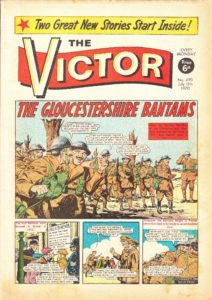
Victor comic, 11 July 1970 – the story of Hardy Falconer Parsons VC
The collection also includes a portrait photograph of Hardy in uniform; the bronze memorial plaque sent, popularly known as the “Dead Man’s Penny” to his parents after the war and his Gloucestershire Regiment collar badge. Engraved on the back of the badge are the words “Irene Randall 10 Newfoundland St., Bristol 1917”. Who she was, and why he had that, we will probably never know….
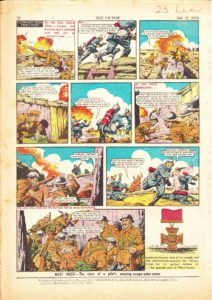
Victor comic, 11 July 1970 – the story of Hardy Falconer Parsons VC
On 11 July 1970, the Victor Comic ran a cartoon story with 10 sketches on its front and back pages, recounting the story of the 14th Gloucesters action at The Knoll and to the deeds of Hardy Falconer Parsons – bringing his heroic actions to the attention of a younger audience.
Ewart Moulton Parsons
And as for the Parsons family, despite Hardy’s death, the war had not finished with them. Hardy had two younger brothers; Ewart Moulton and Lyall Ash. Lyall was born too late to serve but Ewart, born the year after Hardy, was working as an apprentice engineer at Bristol company, Brecknell Munro and Rogers in summer 1916.
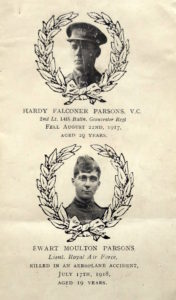
Page from memorial booklet for Hardy and Ewart Parsons
He joined the Royal Flying Corps in 1917 and by 17 July 1918, was a 19 year old Lieutenant and pilot in No.50 Training Depot Station at Eastbourne, flying his Sopwith F1 Camel fighter high above the Seaplane Station. What happened next is still unclear but his plane went into a spin and plummeted to the ground from 3000ft. Unsurprisingly, Ewart was killed instantly.
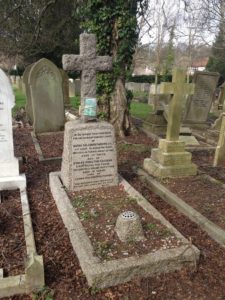
Grave of Ewart Parsons in Canford Cemetery, Bristol
His body was brought back to Bristol and his funeral held at the Old King Street Wesleyan Chapel where his father was the pastor. The coffin was borne by six RAF officers and taken on a gun carriage to Canford Cemetery, where the internment took place followed by the sounding of the Last Post.
So, in the space of eleven months James Ash and Rita Parsons had lost two of their three boys. On the base of the stone cross marking Ewart’s grave at Canford Cemetery the family also commemorated his brother, Hardy. Like so many families across the world, the Parsons’ suffered grievously in the war.
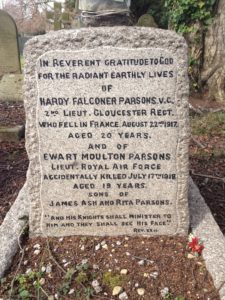
Detail on Ewart Parsons’ grave in Canford Cemetery
But, as this research is primarily based on Hardy I would like to end with a description of him, provided by his father which, when considered alongside his Victoria Cross action, shows him to have been a truly remarkable young man, a perfect example of the loss of the best of that generation:
“Hardy lived all of his life from early childhood on the same high plane of self-forgetfulness and sacrifice in his thought for and service of others”
Hardy Falconer Parsons VC (30 June 1897 – 21 August 1917)
Sources of information consulted for this article include:
Service record of Hardy Falconer Parsons VC (National Archives: WO339/73298)
105 Infantry Brigade War Diary (National Archives: WO95/2486)
14 Battalion Gloucestershire Regiment War Diary (National Archives: WO95/2486)
RAF service record of Ewart Moulton Parsons
Census returns (1901 & 1911)
Material from the Soldiers of Gloucestershire Museum http://www.soldiersofglos.com/
Victor Comic, 11 July 1970
London Gazette – various dates
The Kingswood Magazine, Vol. XX, No.10, December 1917
North Devon Journal, 27 August 1931
North Devon Journal, 10 November 1949
Gliddon, Gerald, VCs of the First World War: Cambrai 1917, Stroud, 2004

Second Lieutenant Hardy Falconer Parsons VC, 14th Gloucestershire Regiment. Image courtesy Soldiers of Gloucestershire Museum, Ref GLRRM:04750.6
On 8 November 2017 a Bristol Civic Society Blue Plaque for Hardy Falconer Parsons VC, 14th Gloucestershire Regiment (my local Victoria Cross recipient) will be unveiled at 54 Salisbury Road, Redland, Bristol. The date is 100 years to the day after King George V personally presented Hardy’s VC to his father, Rev James Ash Parsons at a ceremony on Durdham Downs.
Between 2014 and 2019 the Government is funding the production and placing of a commemorative stone for each and every Victoria Cross recipient of the First World War. Although Hardy Falconer Parsons lived at 54 Salisbury Road, he was not born in Bristol. So in August the government-funded commemorative stone relating to Hardy Parsons, was laid in Rishton, Lancashire.
Local historian and author Clive Burlton and I were determined to see Hardy’s strong association with Bristol and the West Country recognised. If we couldn’t have the government-funded stone in Bristol, the next best thing was to have a Bristol Blue plaque unveiled in his honour.
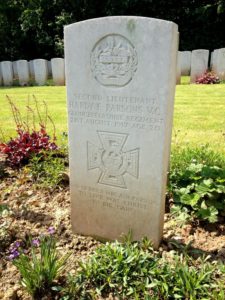
The grave of Hardy Falconer Parsons VC at Villers-Faucon Communal Cemetery
So, during the past year we have organised for the creation of the plaque. Wednesday’s ceremony, starting at 11am, will have representatives from the Bristol Civic Society; the former Gloucestershire Regiment; the Soldiers of Gloucestershire Museum; the Bristol University Officer Training Corps; Kingswood School, Bath, Redland Green School and Dolphin Schools in Bristol; bandsmen from the Salamanca Band of the Rifles Regiment; the Western Front Association; members of the Bristol Great War network and representatives of the Kingswood Association, whose generous donation enabled the plaque to be made and installed. Also attending are the Lord Mayor of Bristol, Cllr Lesley Alexander; the Deputy Lord-Lieutenant for the County and City of Bristol, Colonel Andrew Flint and the Dean of Bristol, the Very Rev Dr David Hoyle.
The event is open to the public so please do come along and attend if you can. I will be posting the results of my research on Hardy Parsons along with photos of Wednesday’s ceremony on my website later this week. In the meantime, it is worth reading Hardy’s VC citation to have an idea of his valour:
“For most conspicuous bravery during a night attack by a strong party of the enemy on a bombing post held by his command. The bombers holding the block were forced back, but Second Lieutenant Parsons remained at his post, and, single-handed, and although severely scorched and burnt by liquid fire, he continued to hold up the enemy with bombs until severely wounded. This very gallant act of self-sacrifice and devotion to duty undoubtedly delayed the enemy long enough to allow the organisation of a bombing party, which succeeded in driving back the enemy before they could enter any portion of the trenches. This gallant officer succumbed to his wounds.”
There should be a short film on Hardy’s action on Wednesday evening’s Points West (BBC1) from 6.30pm.
